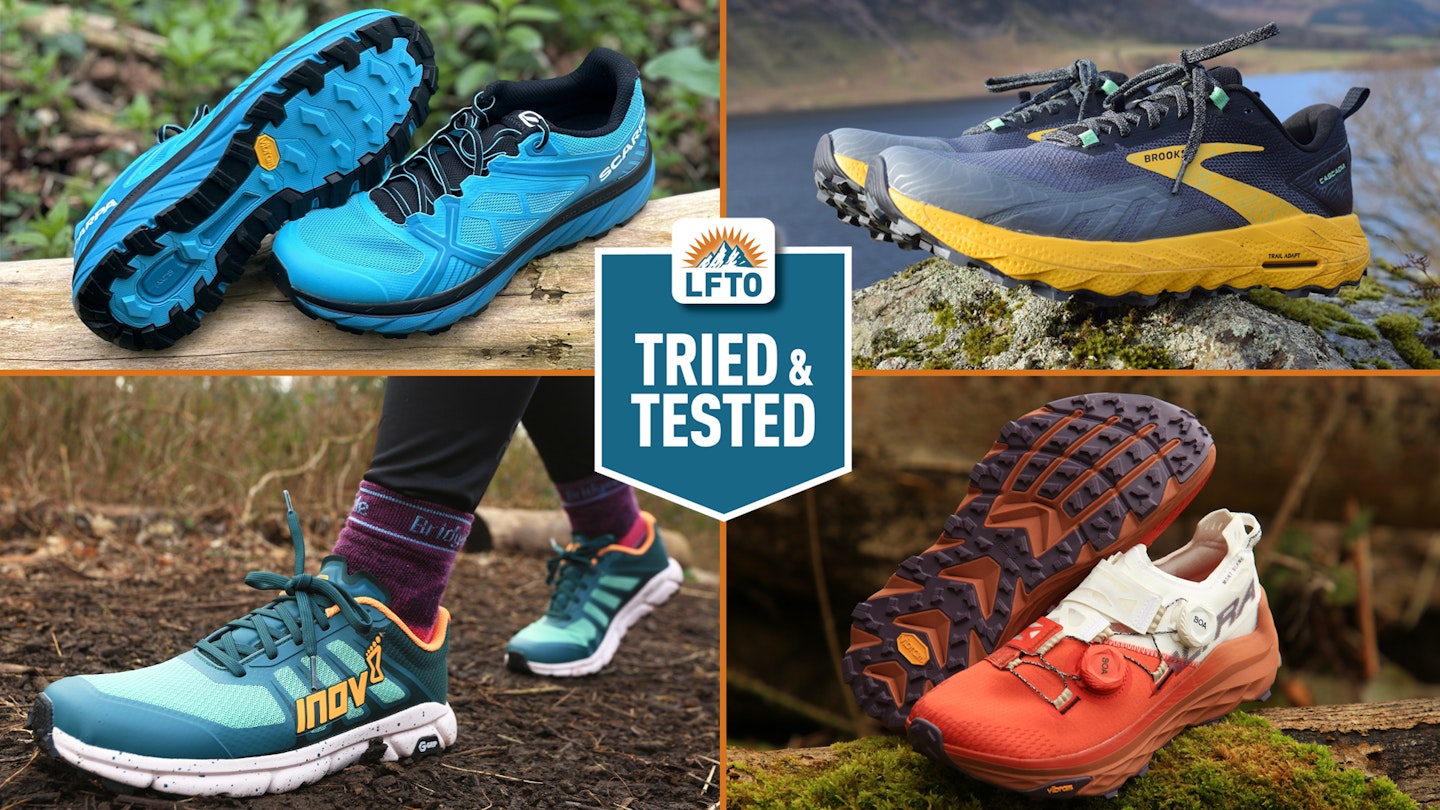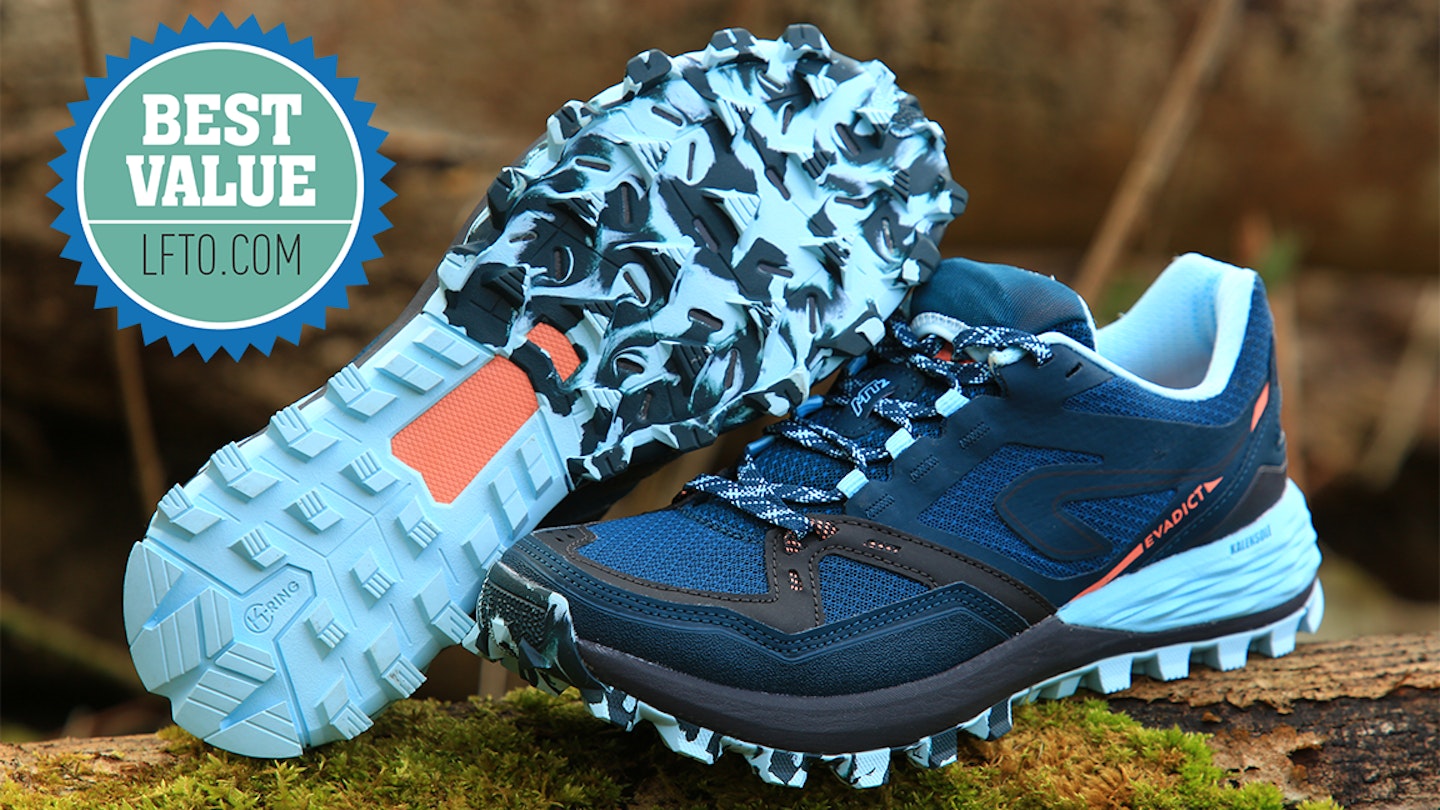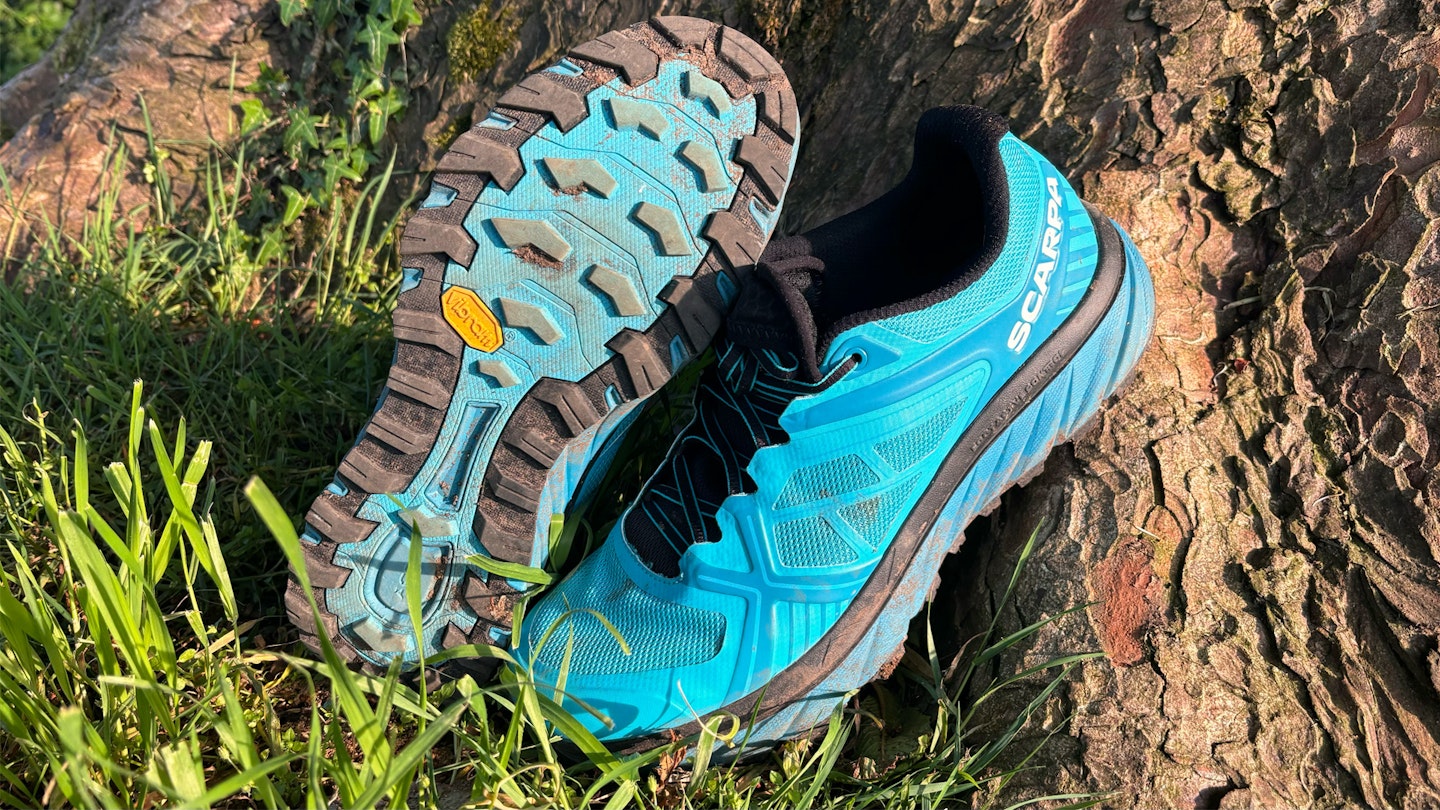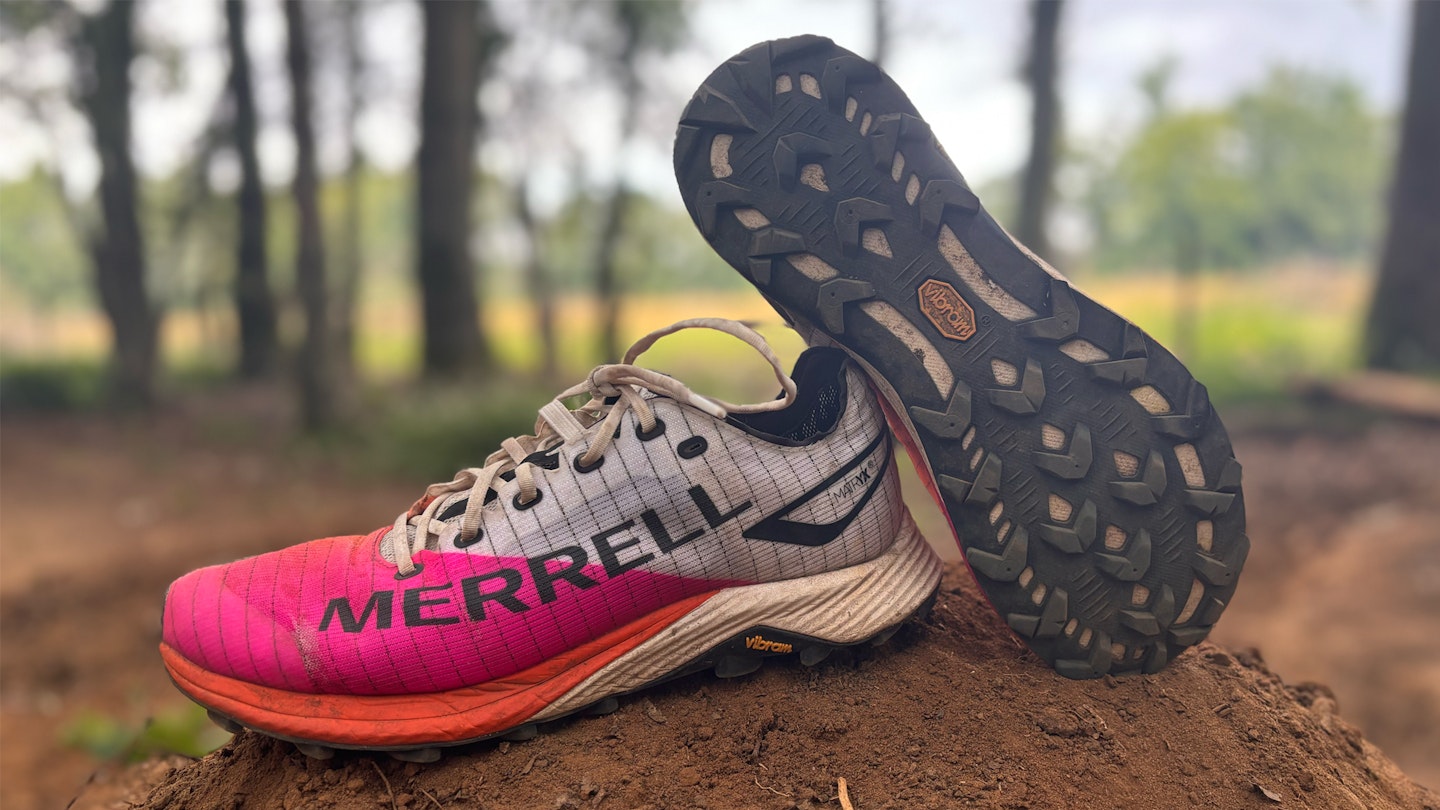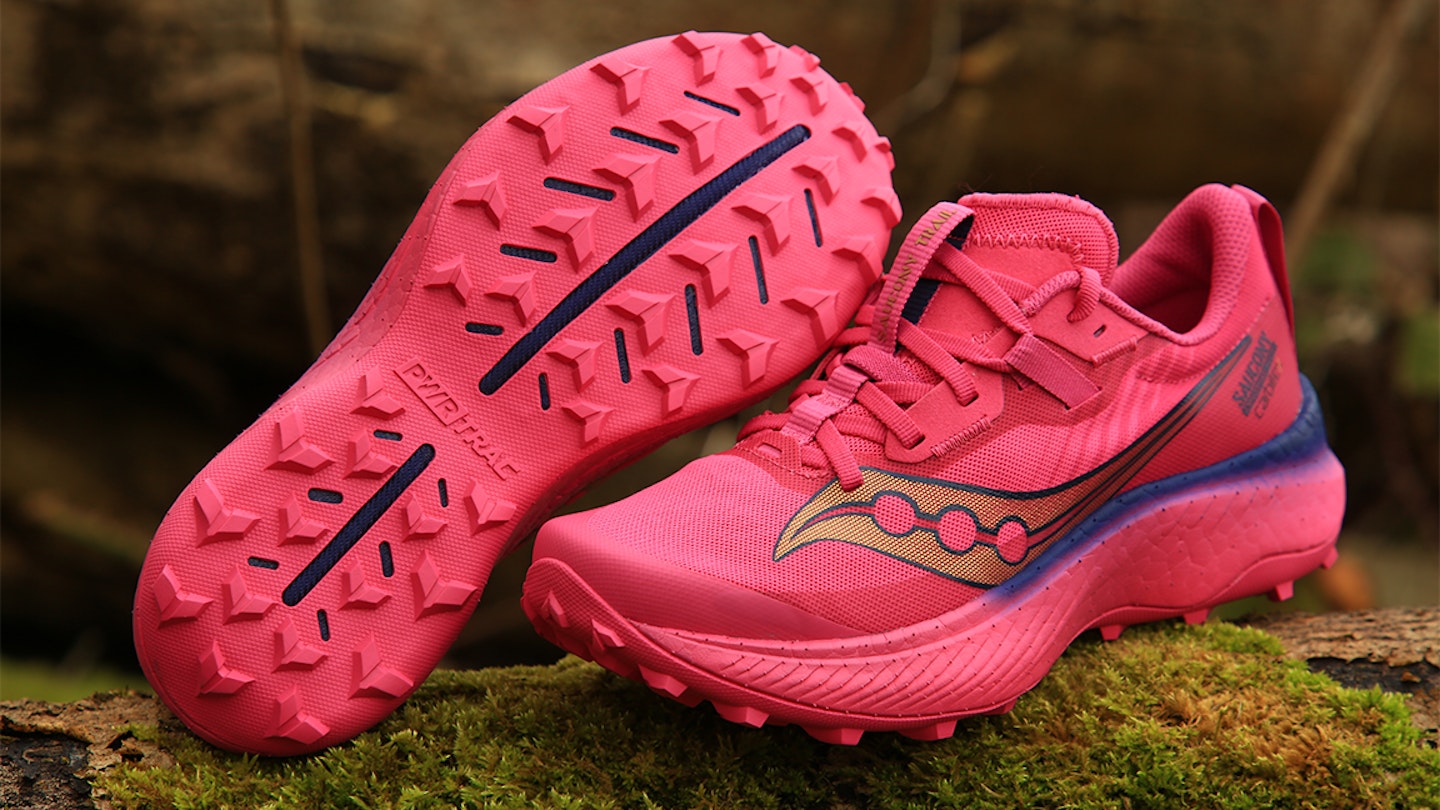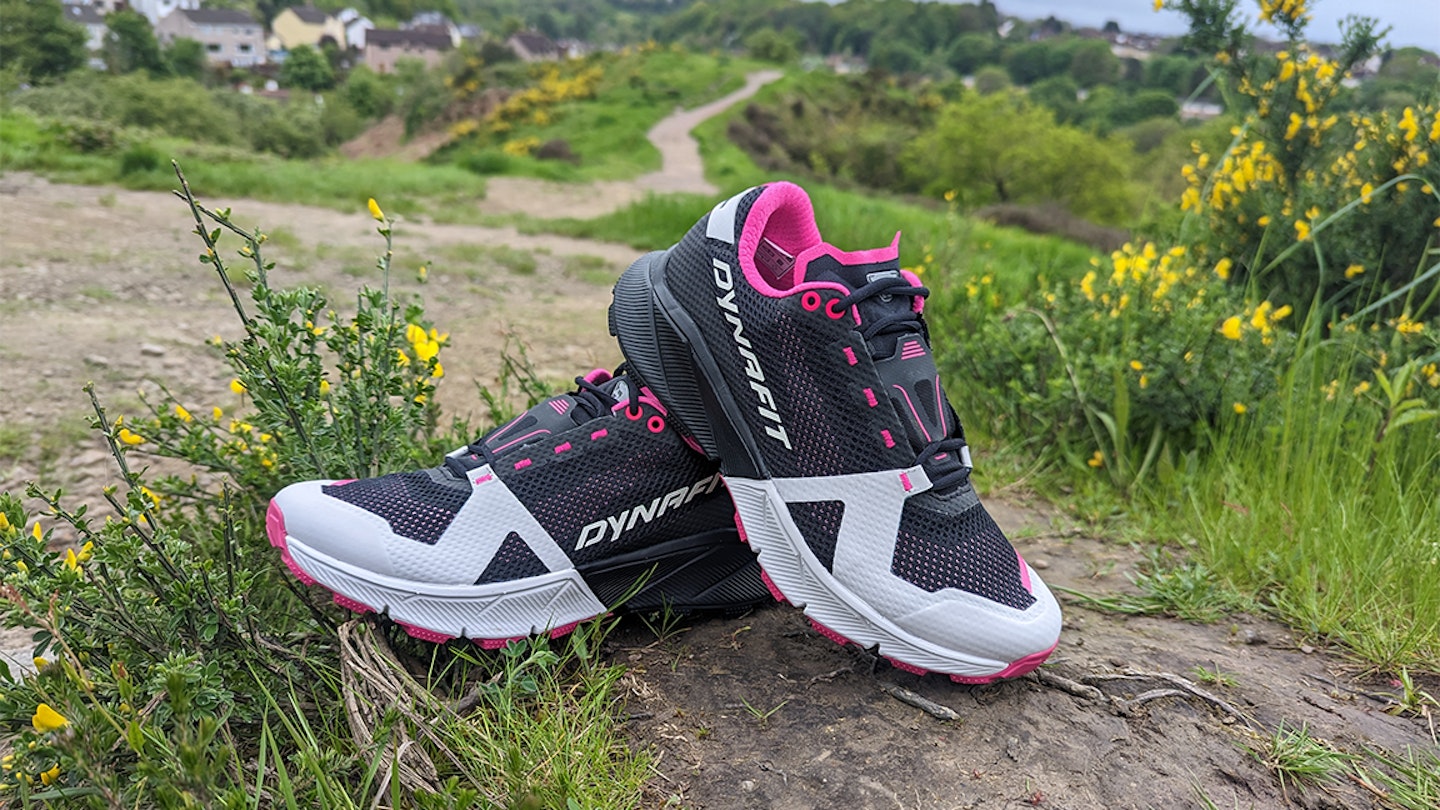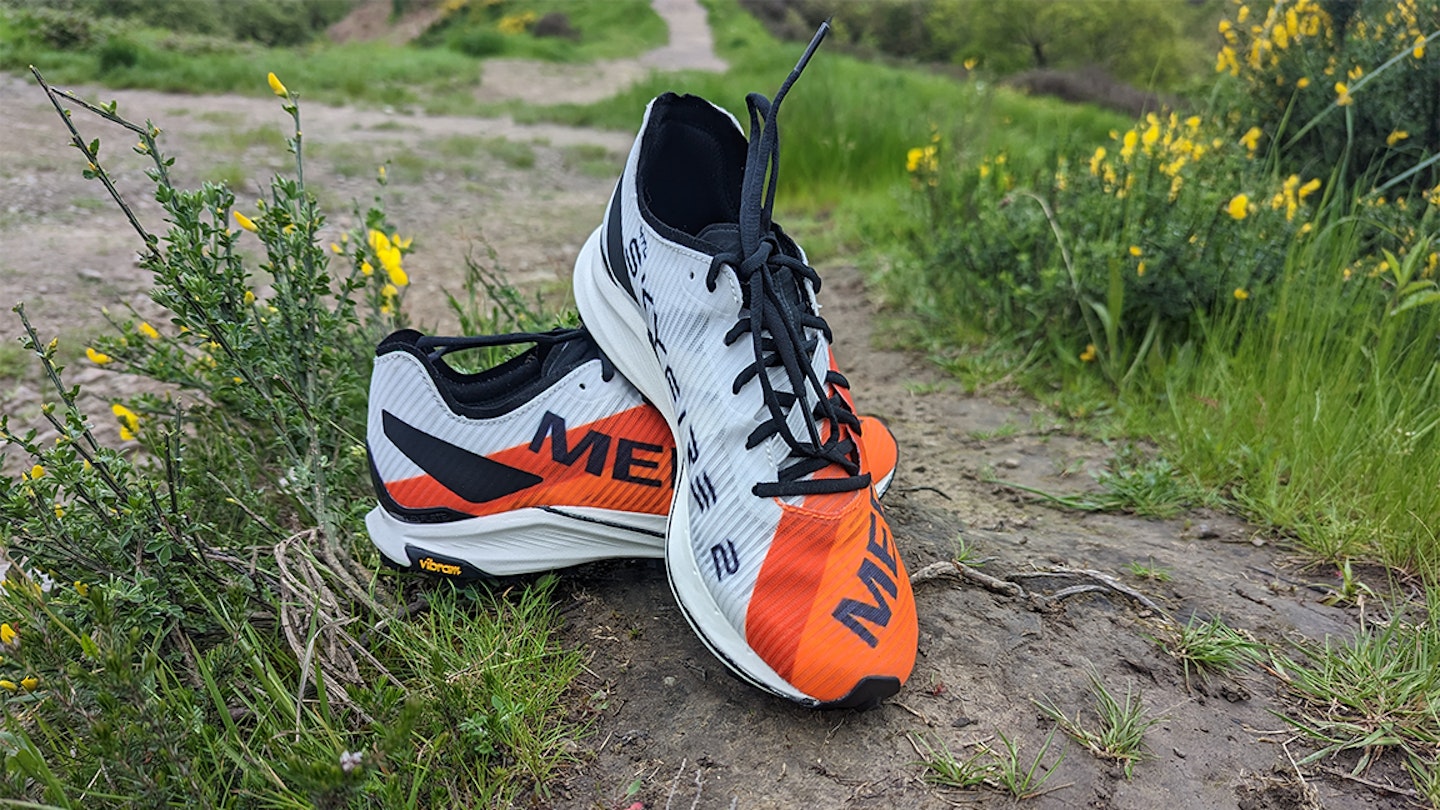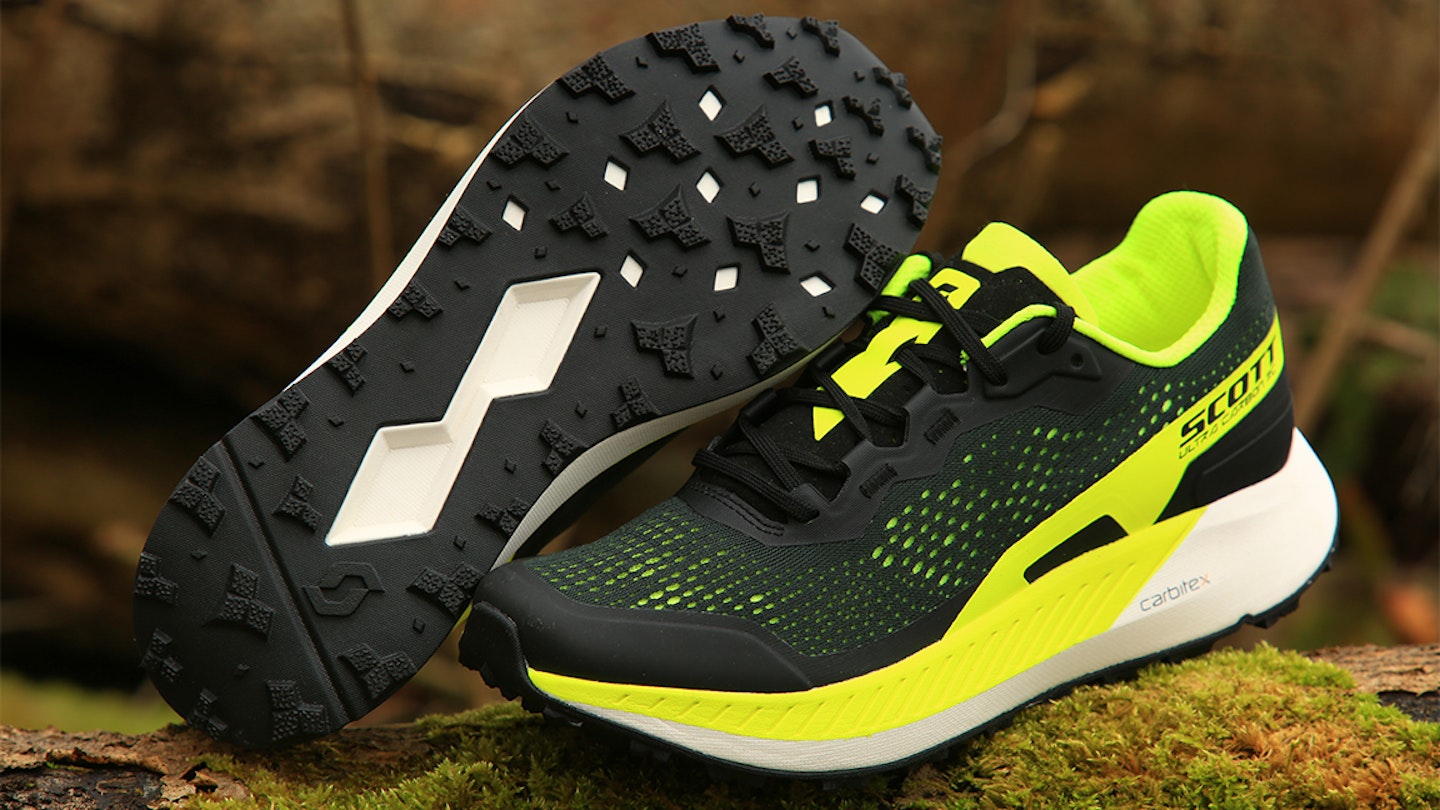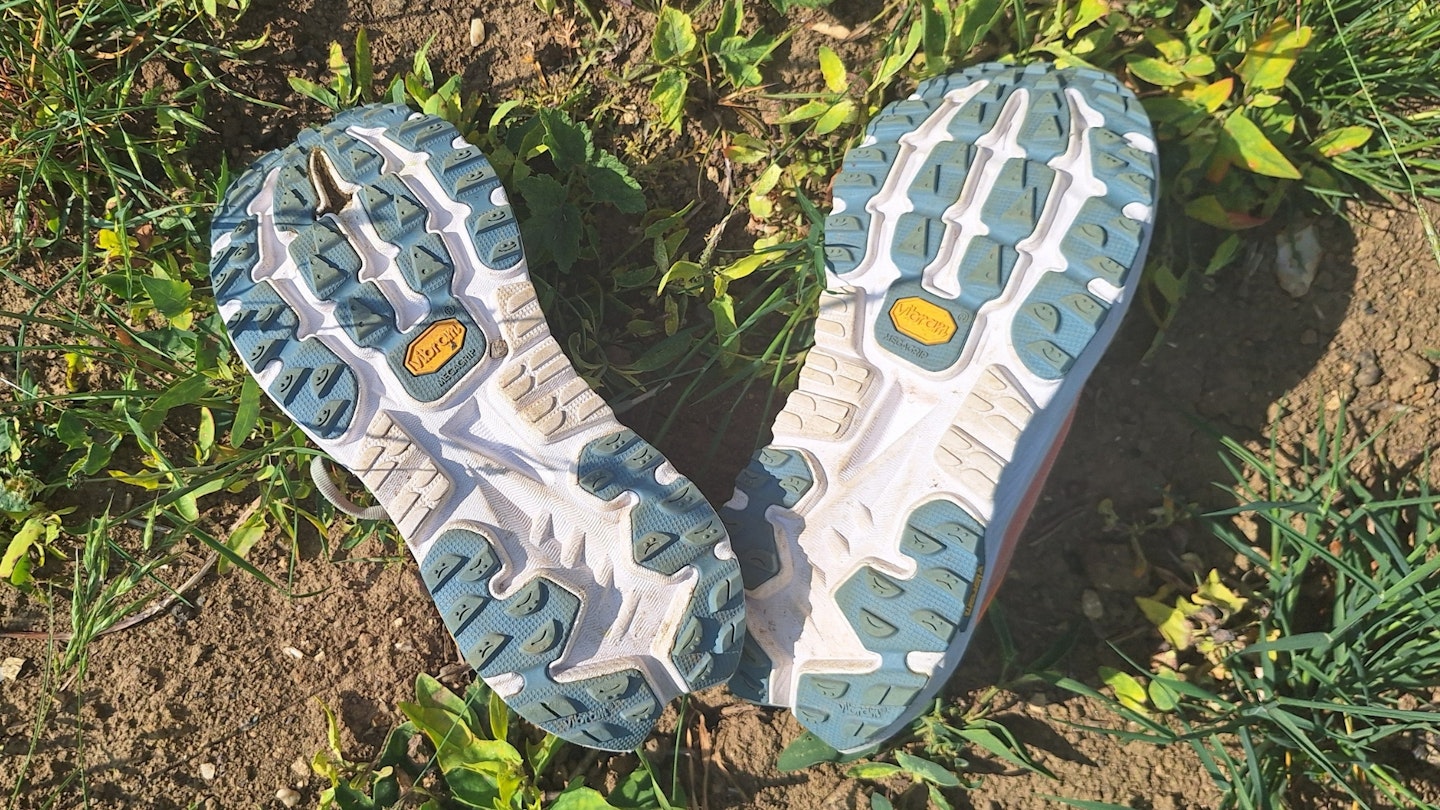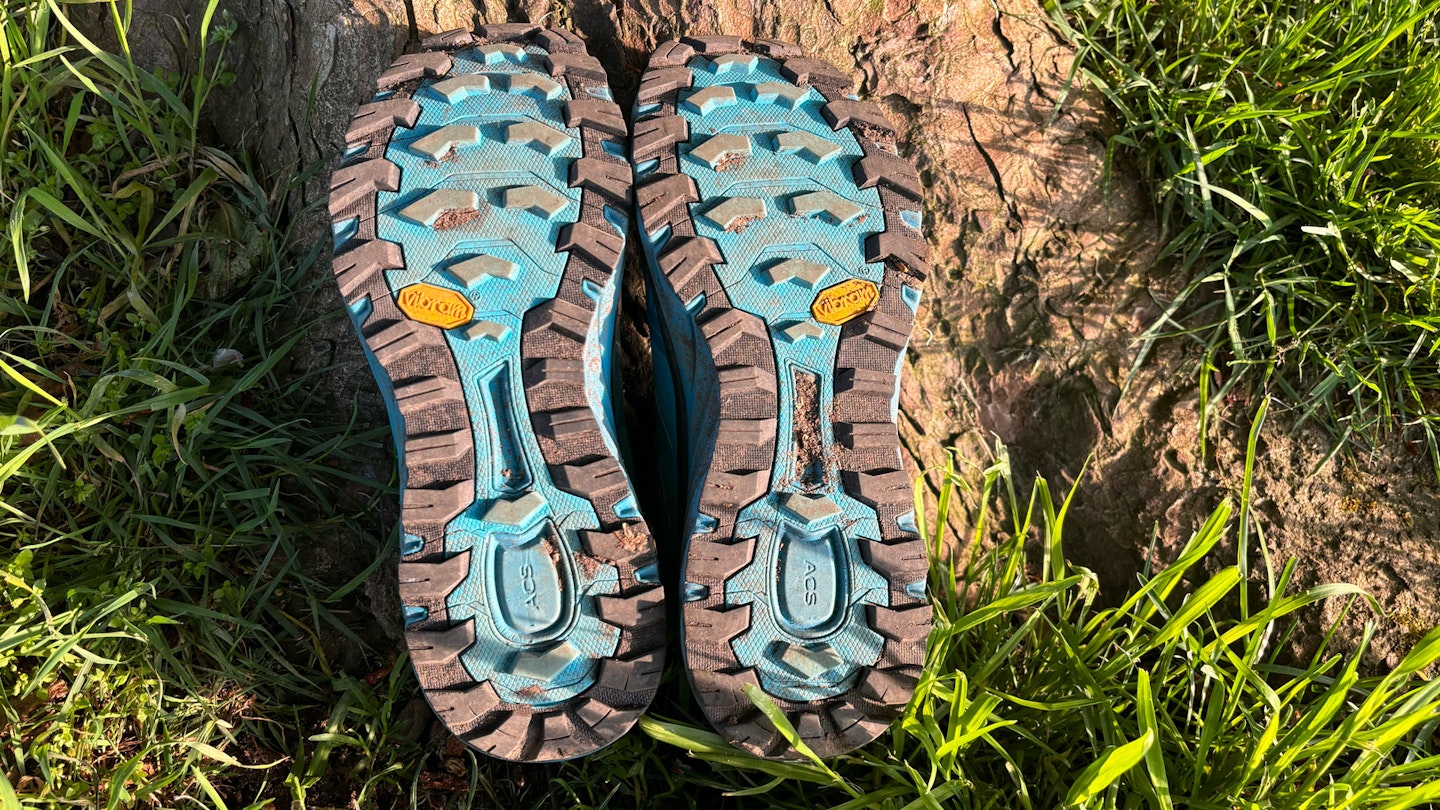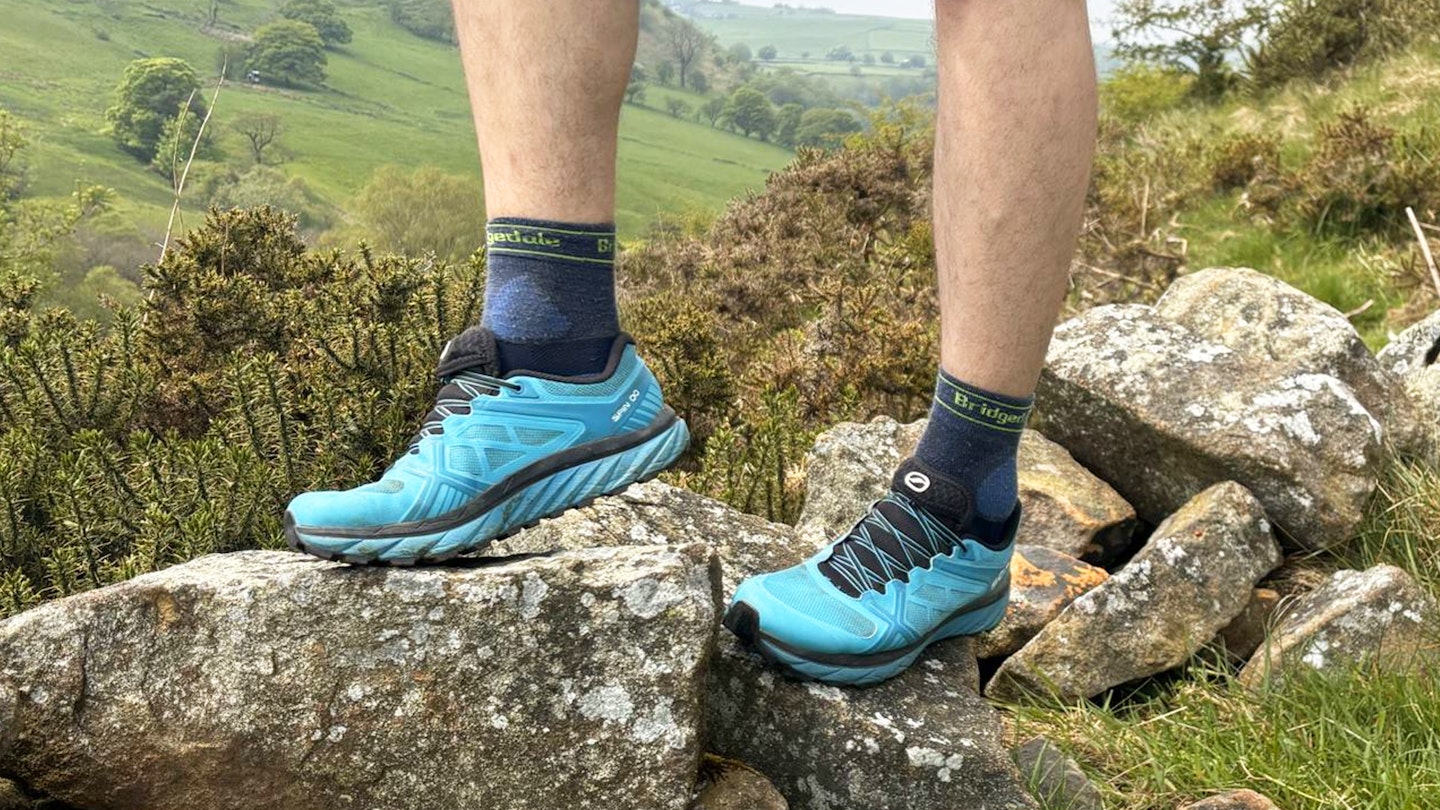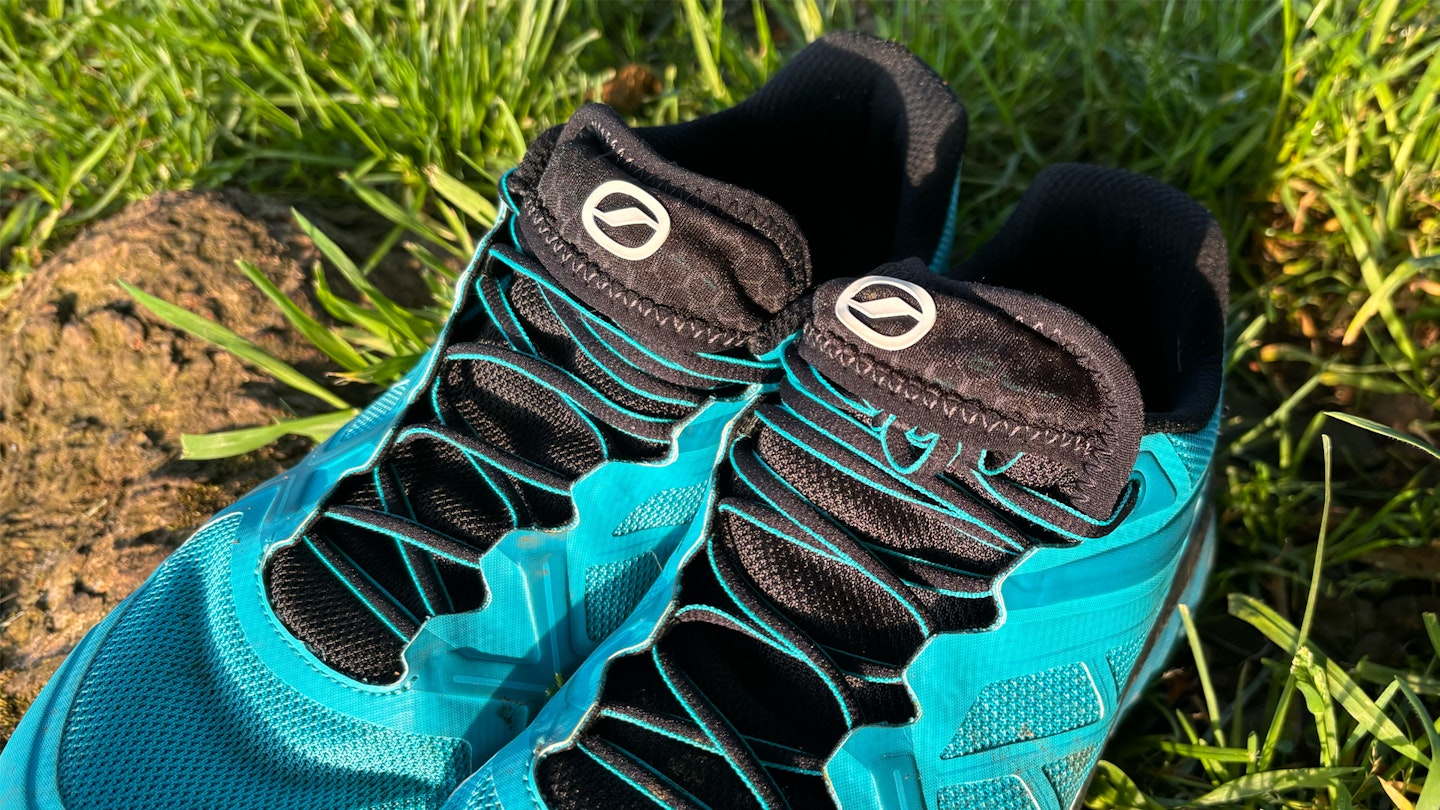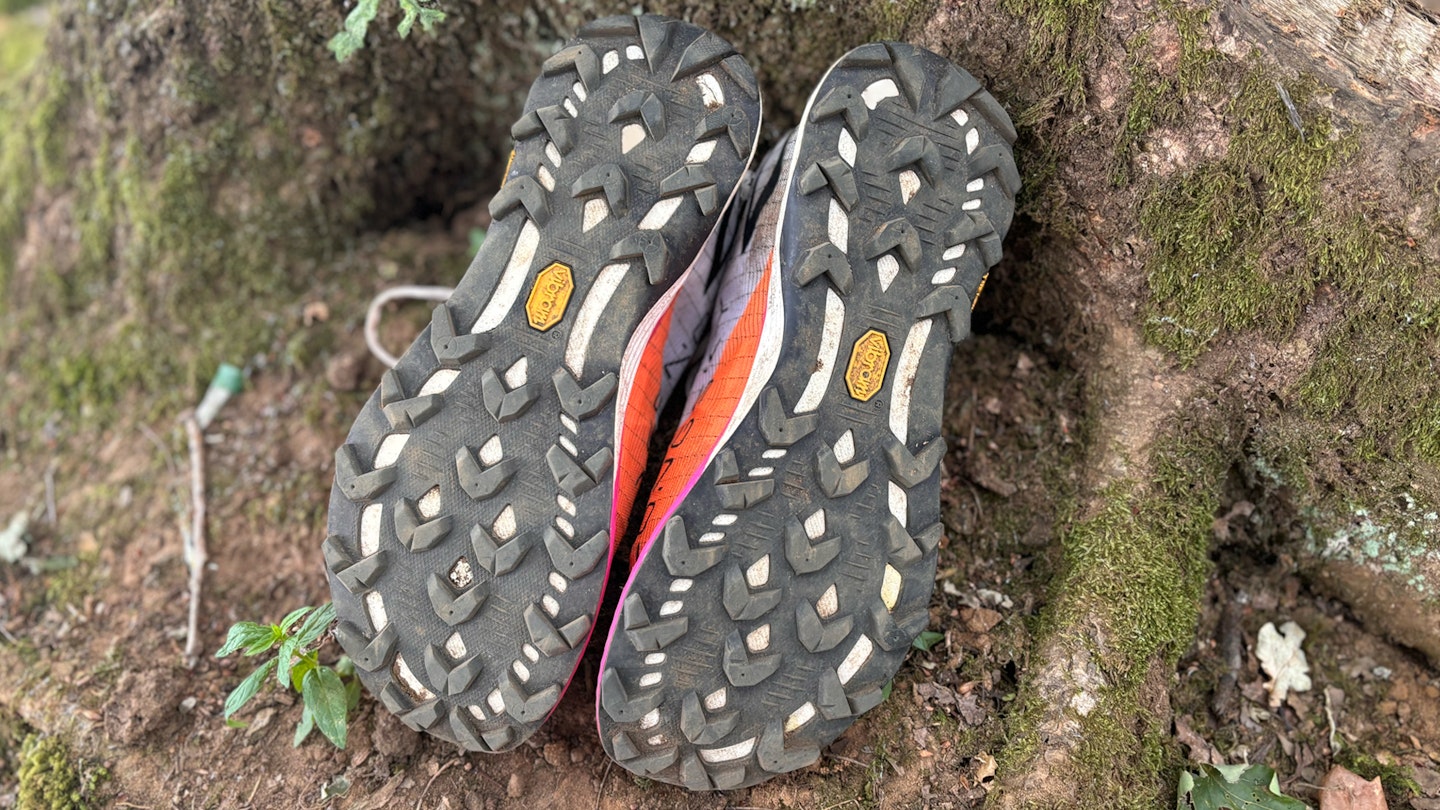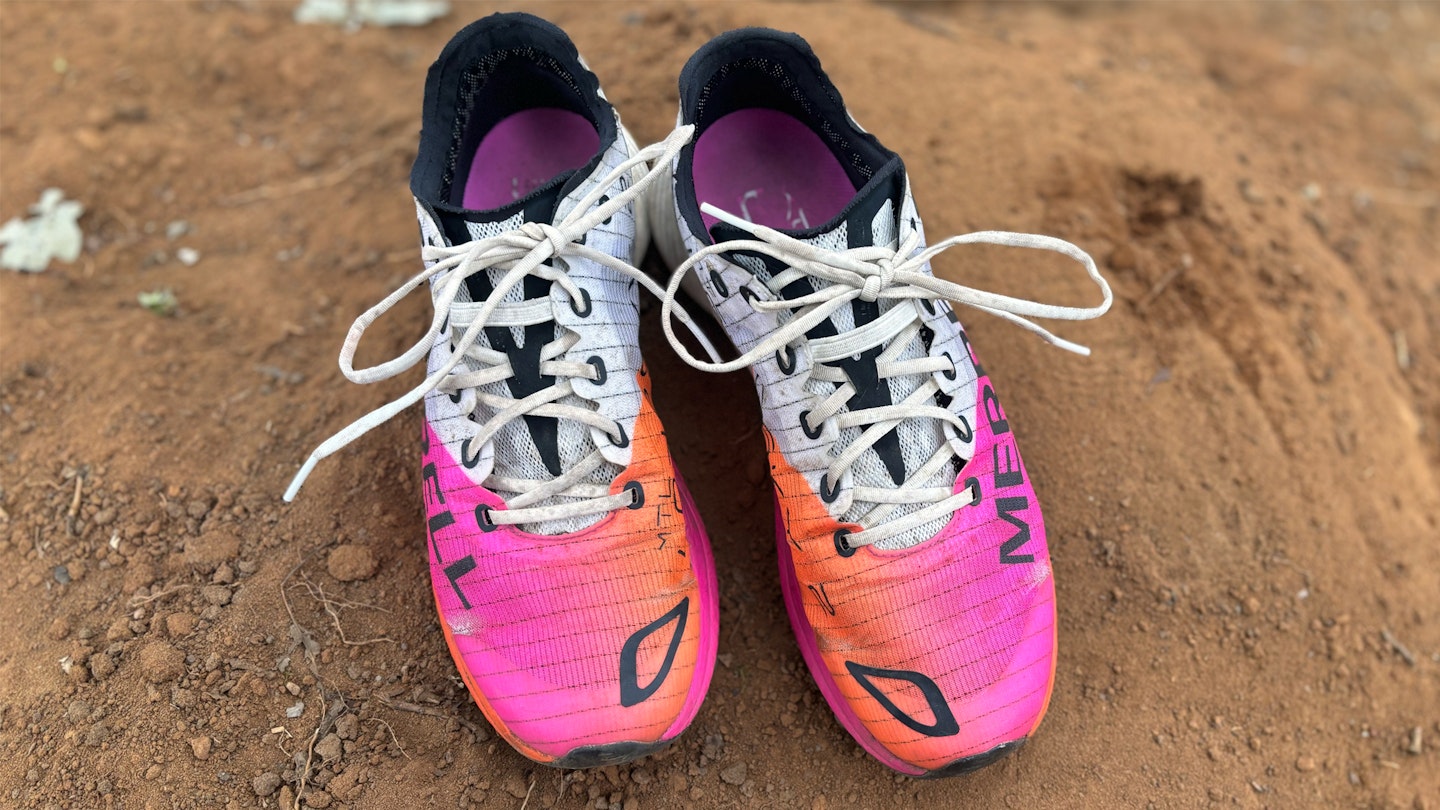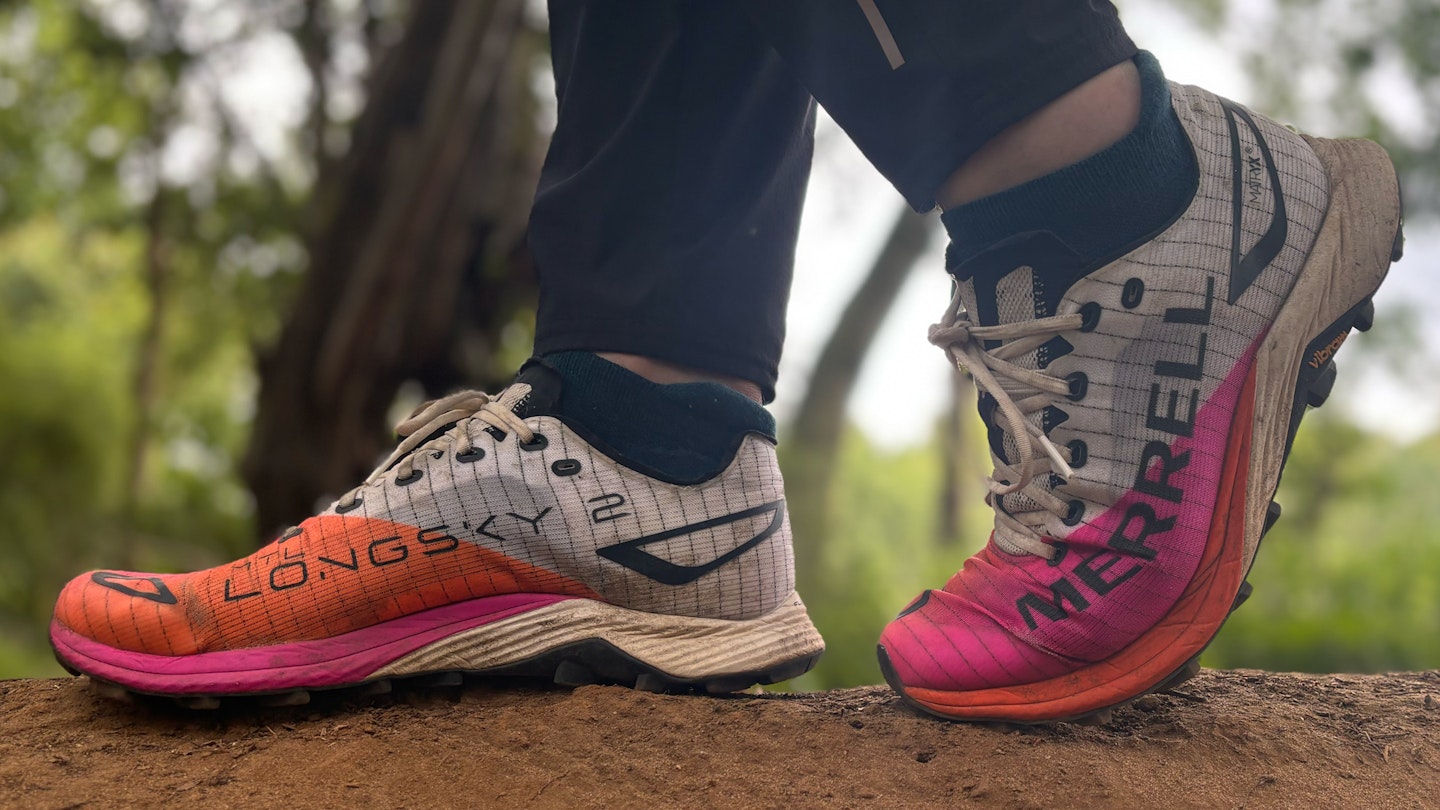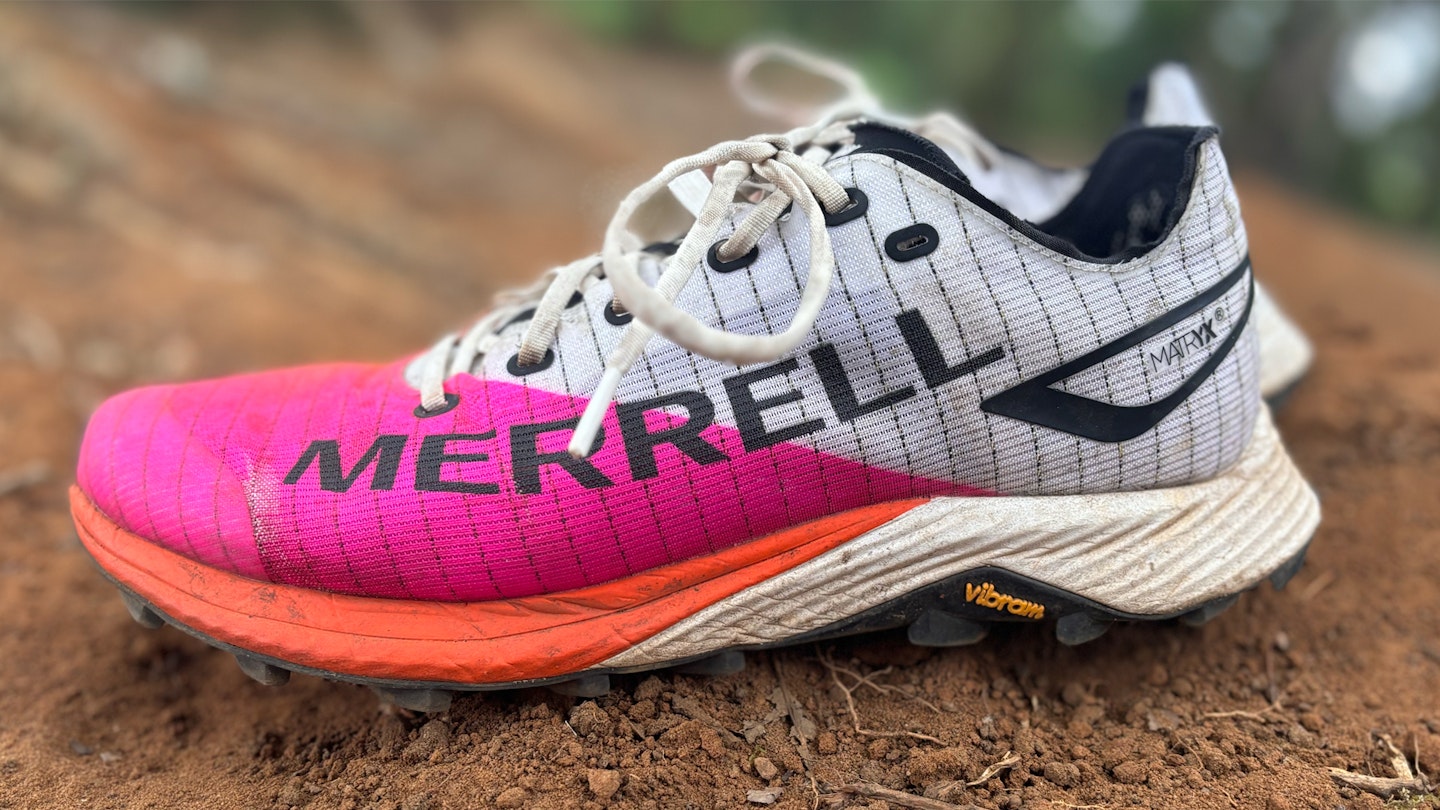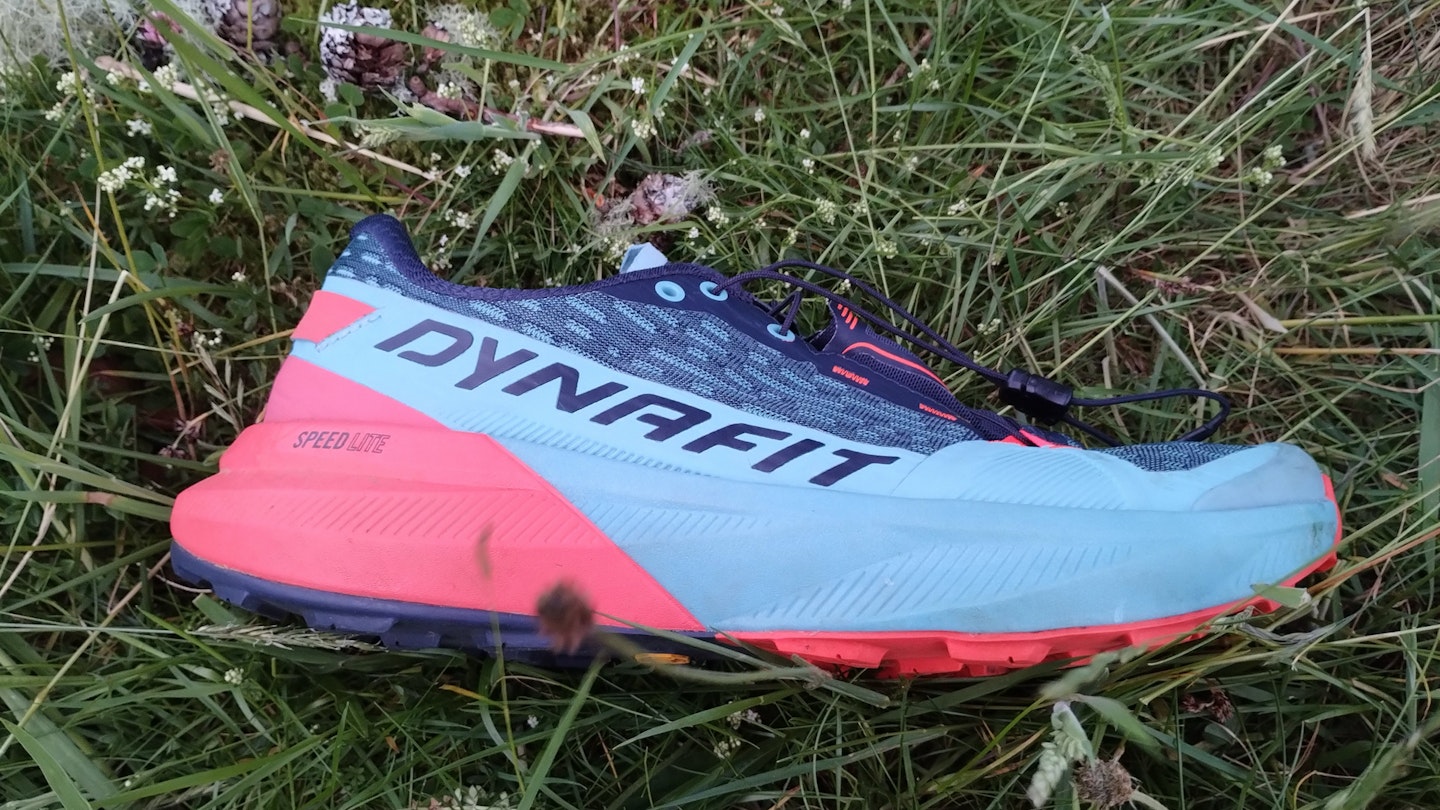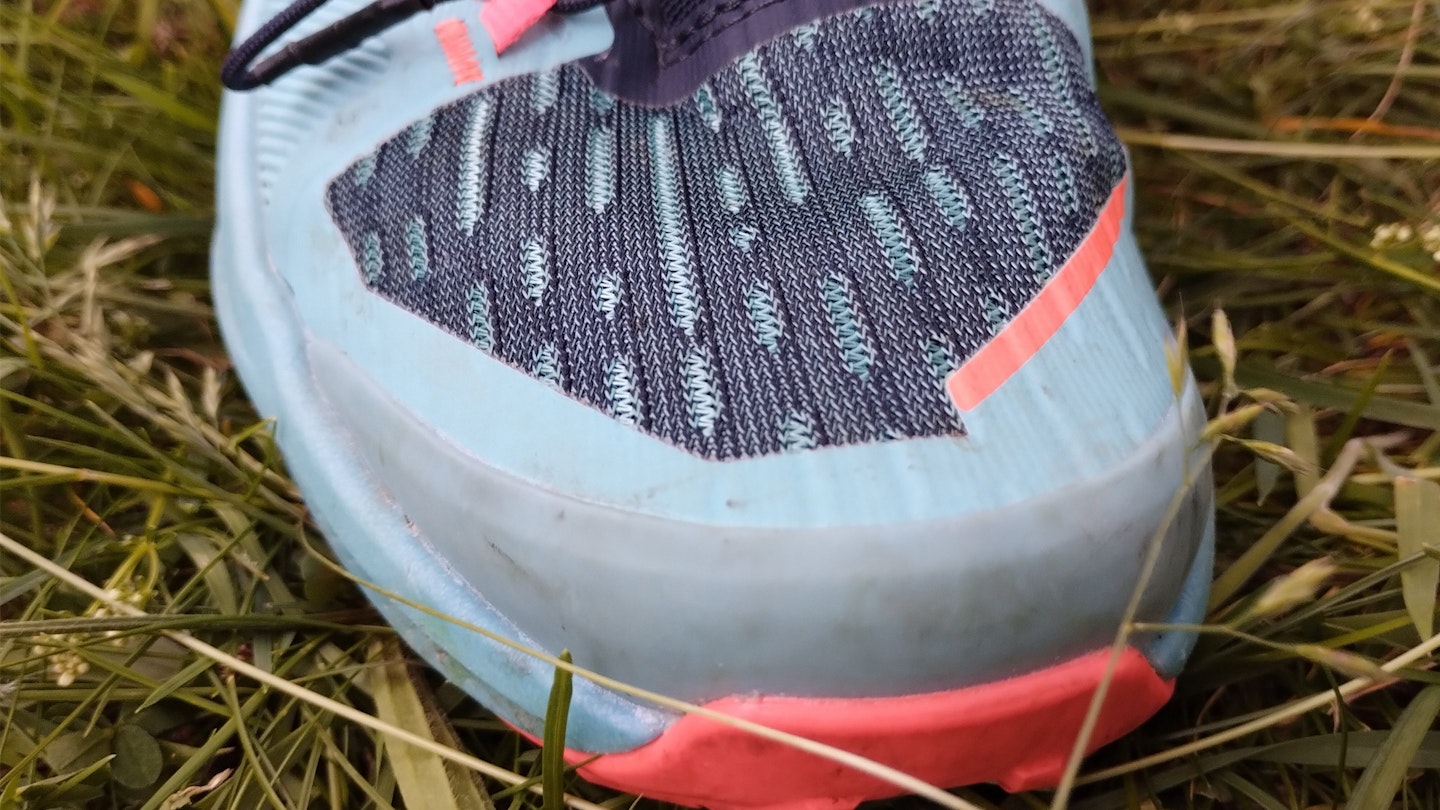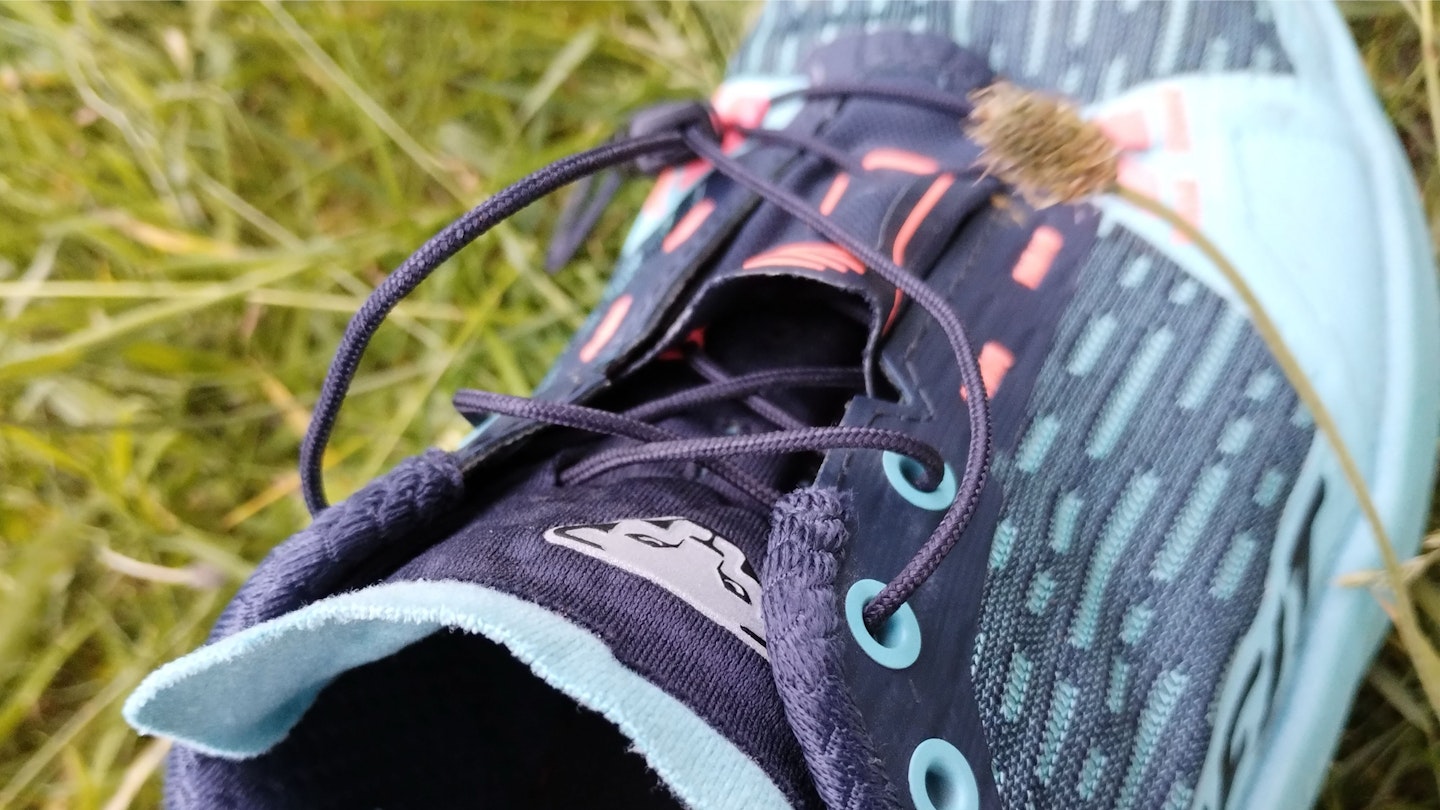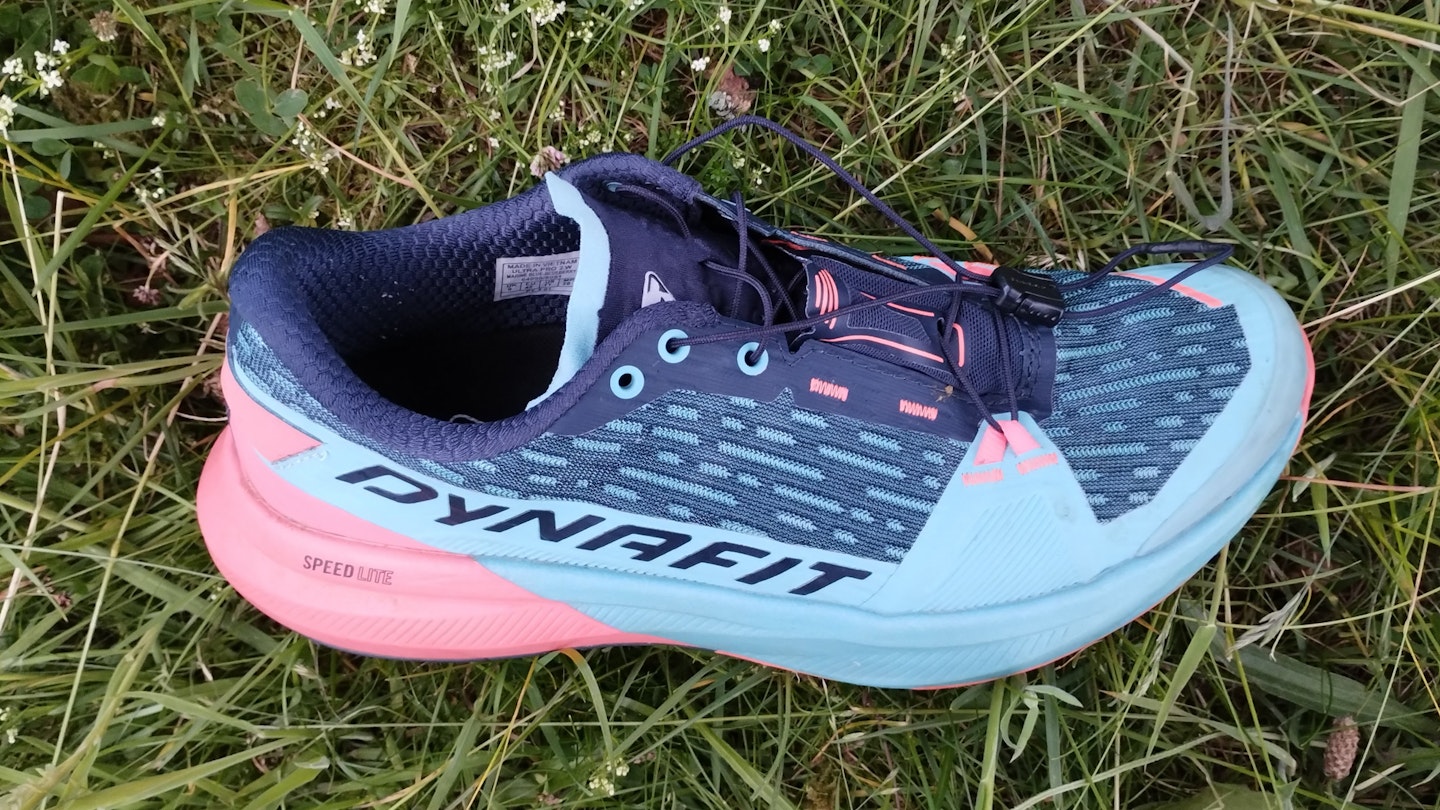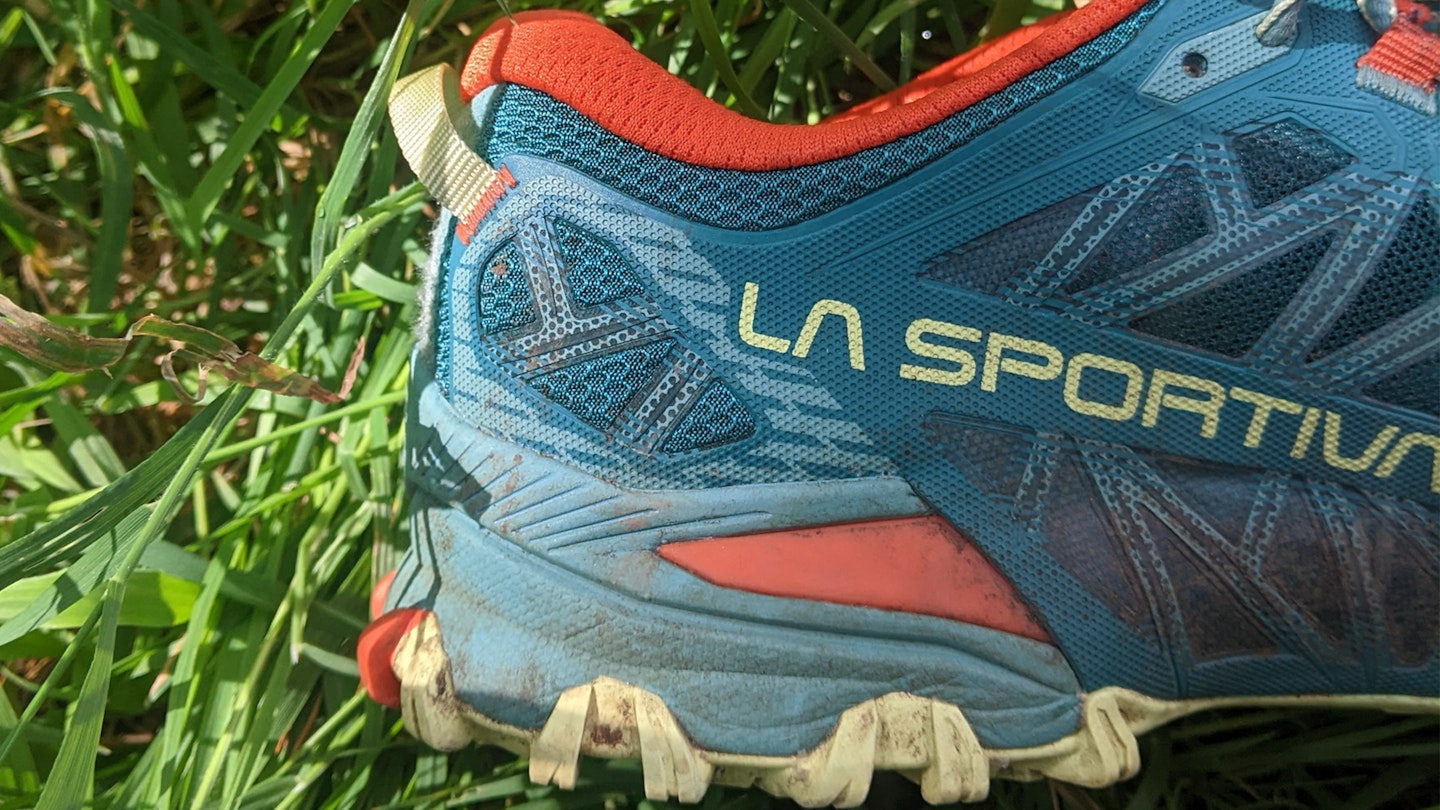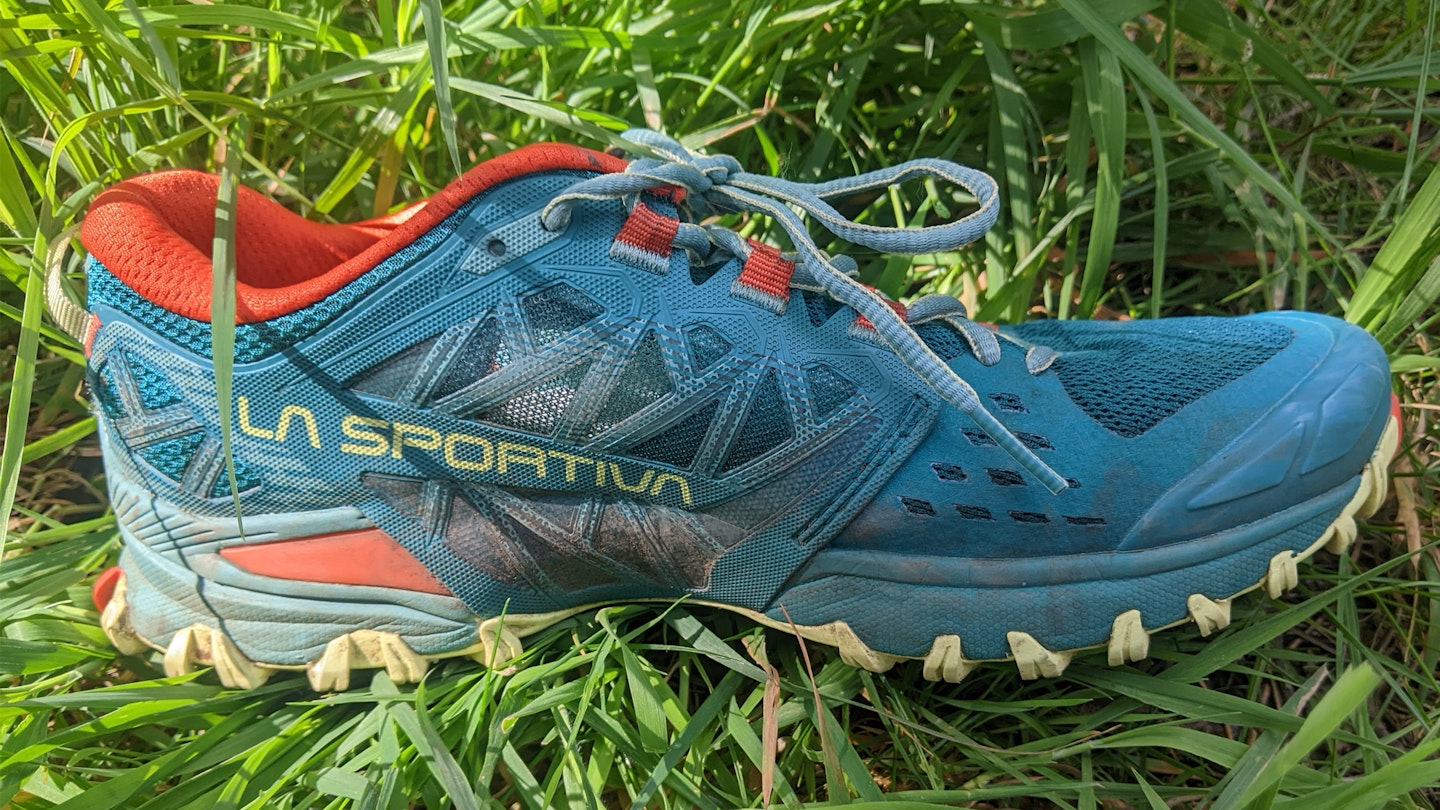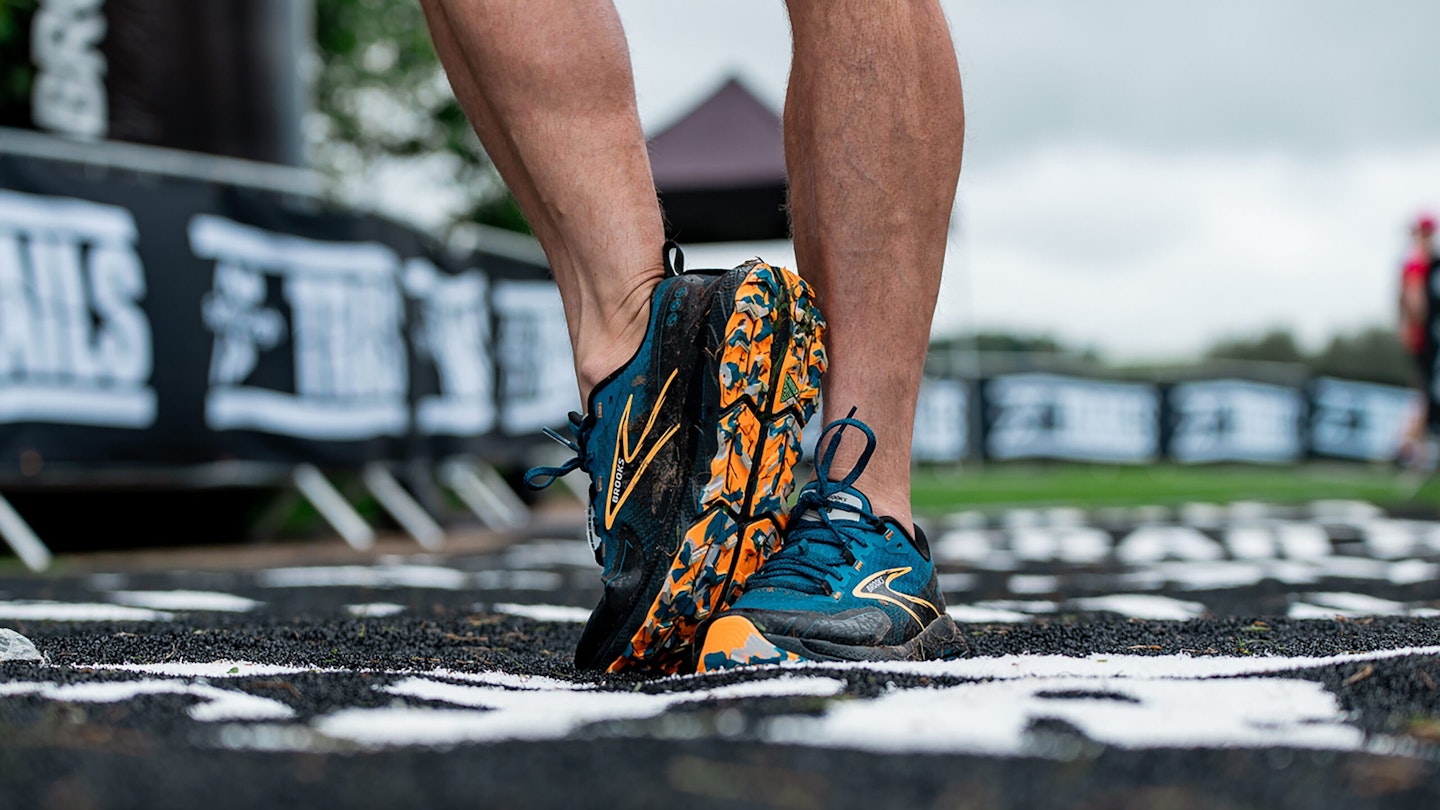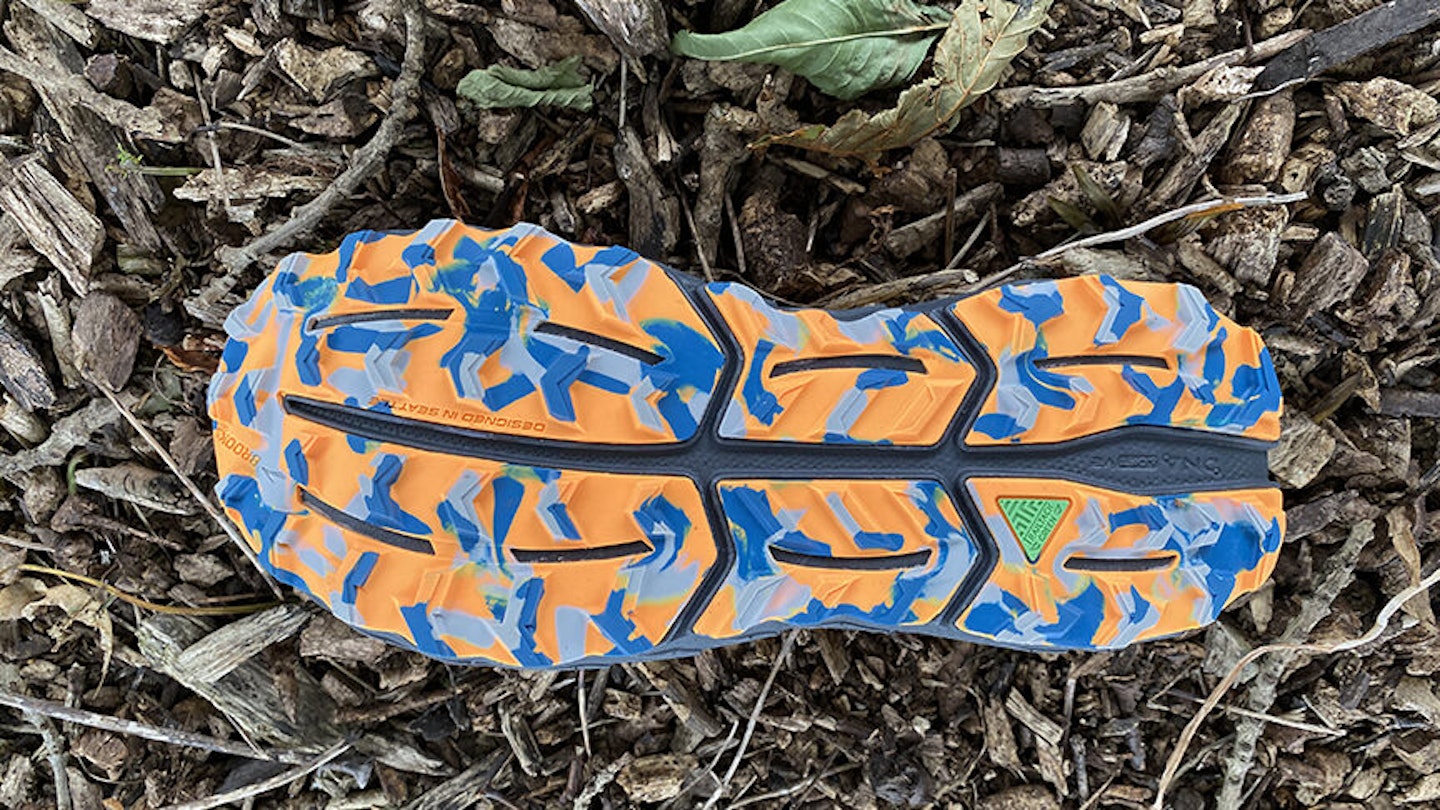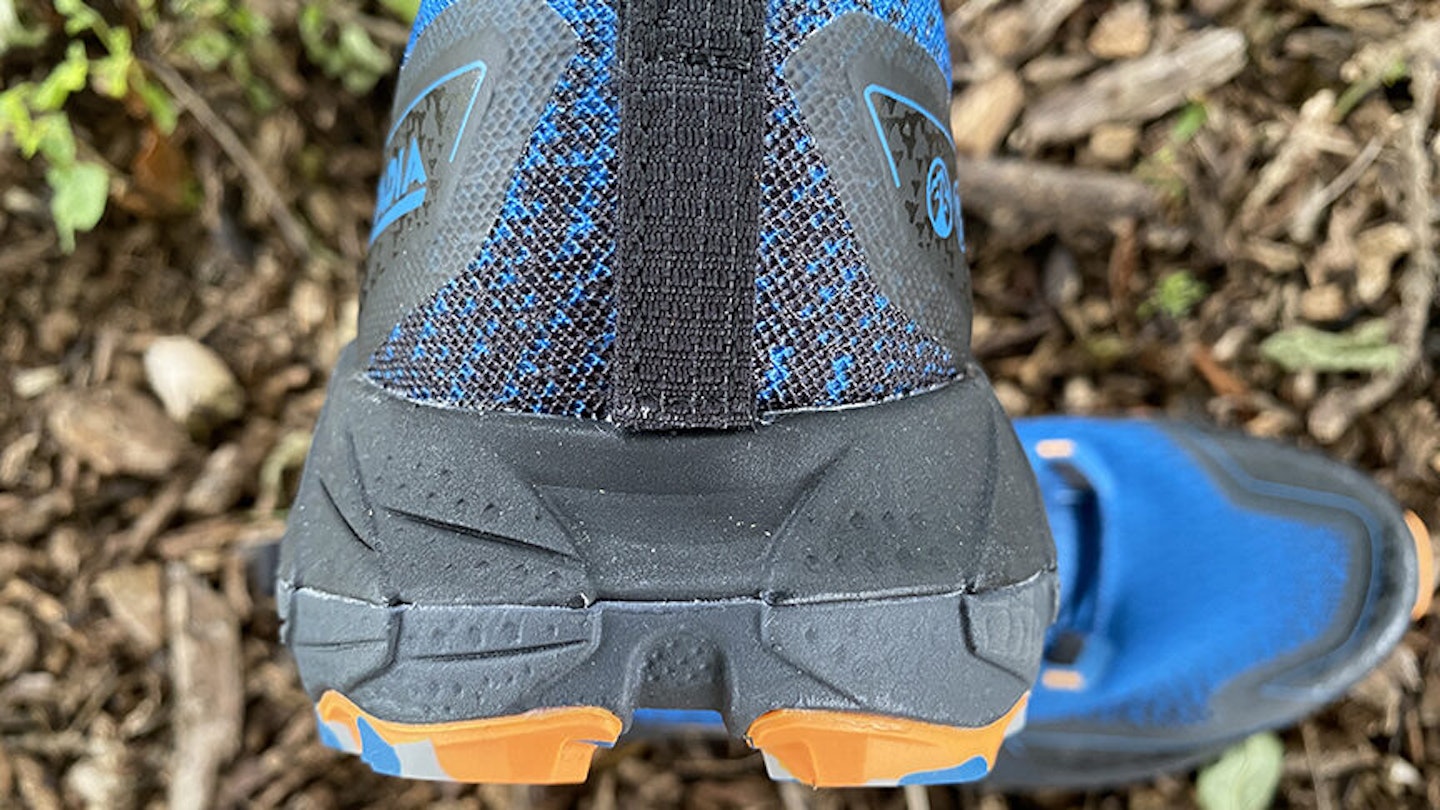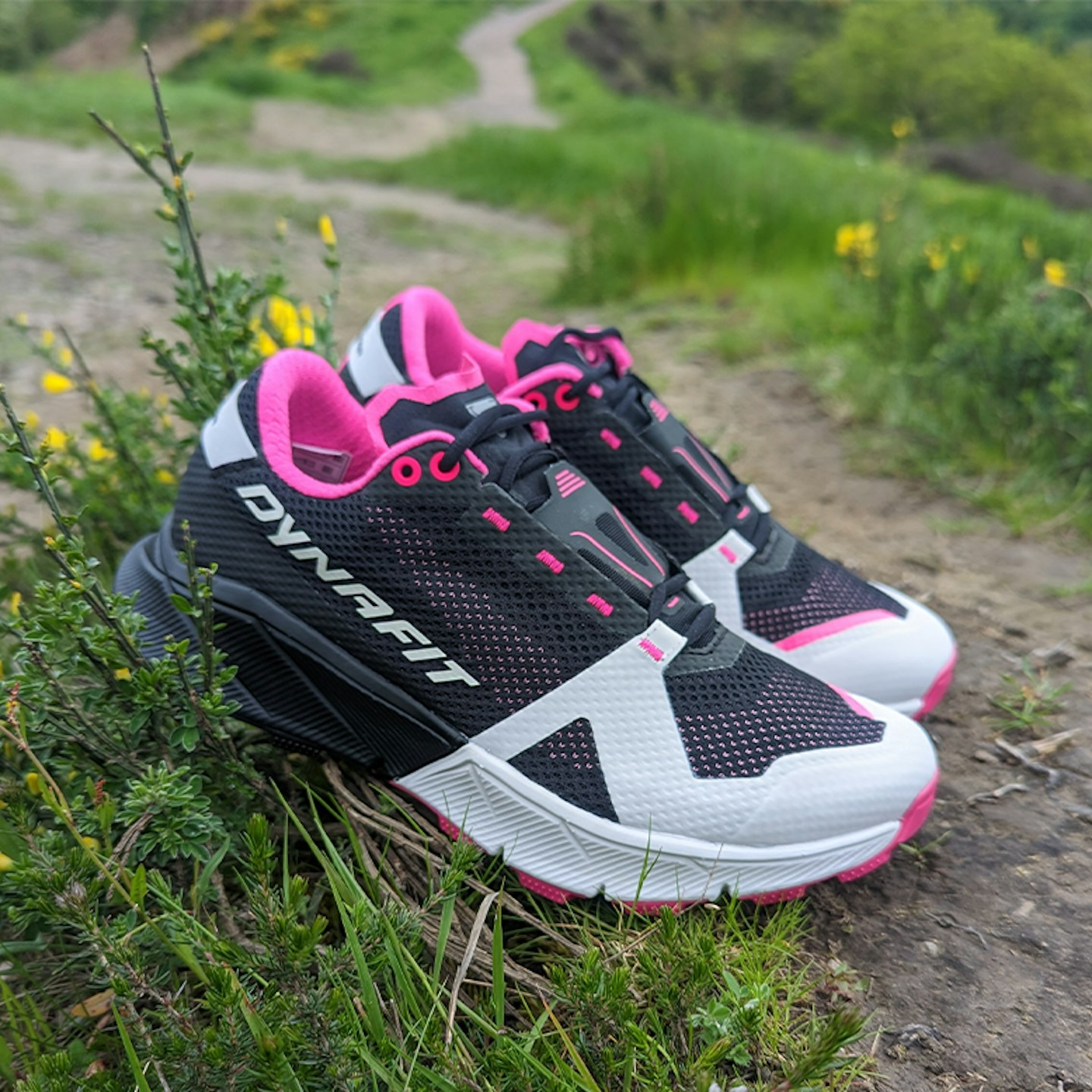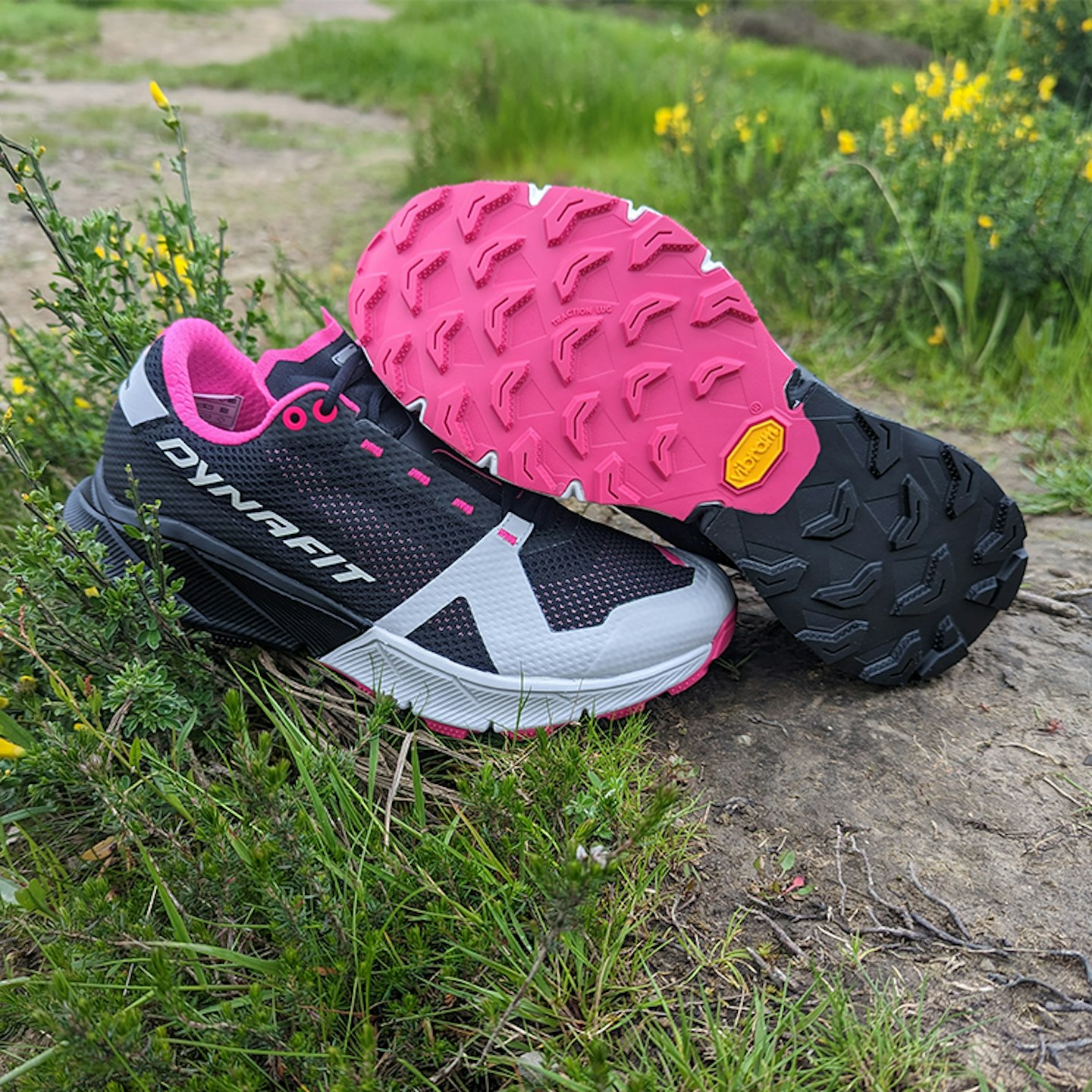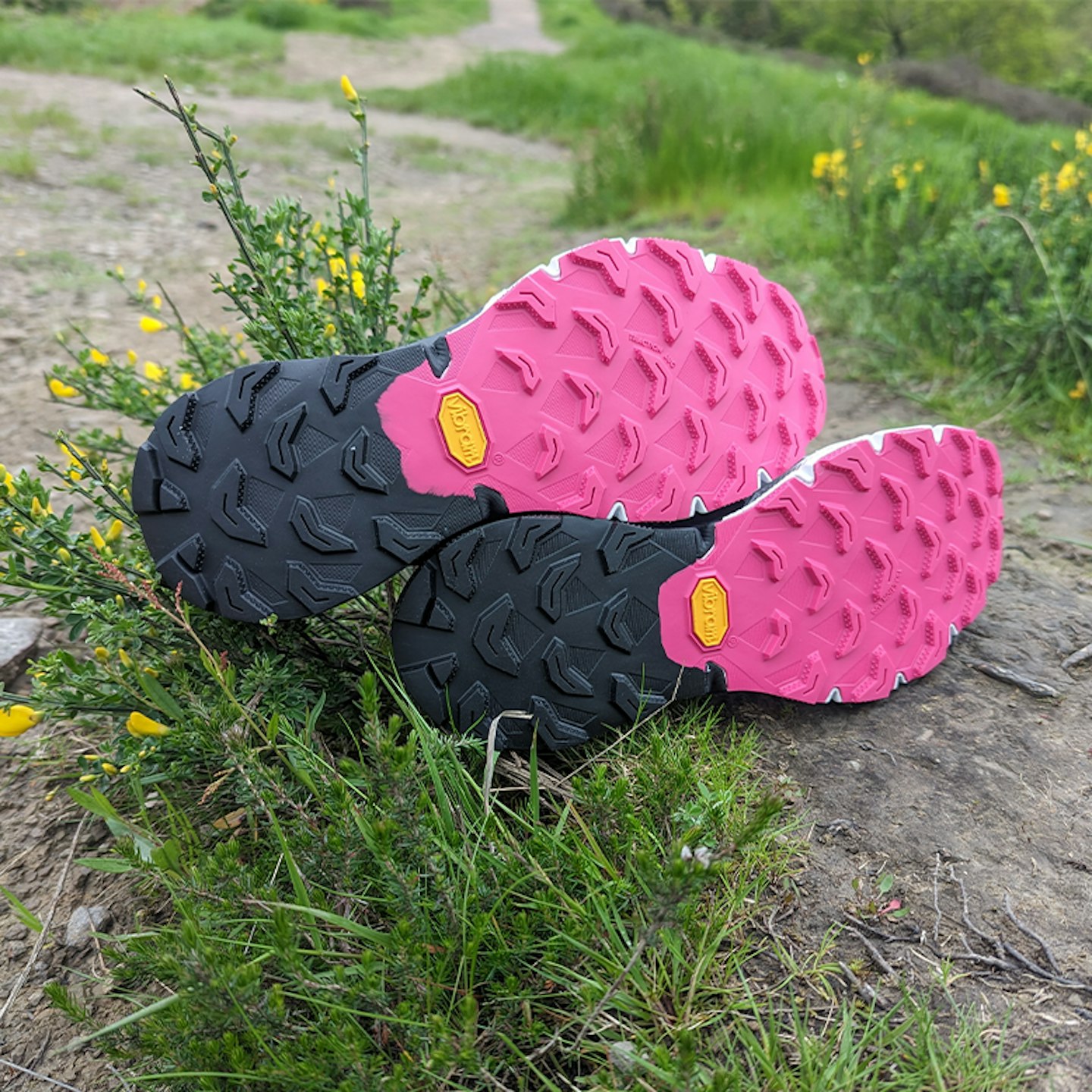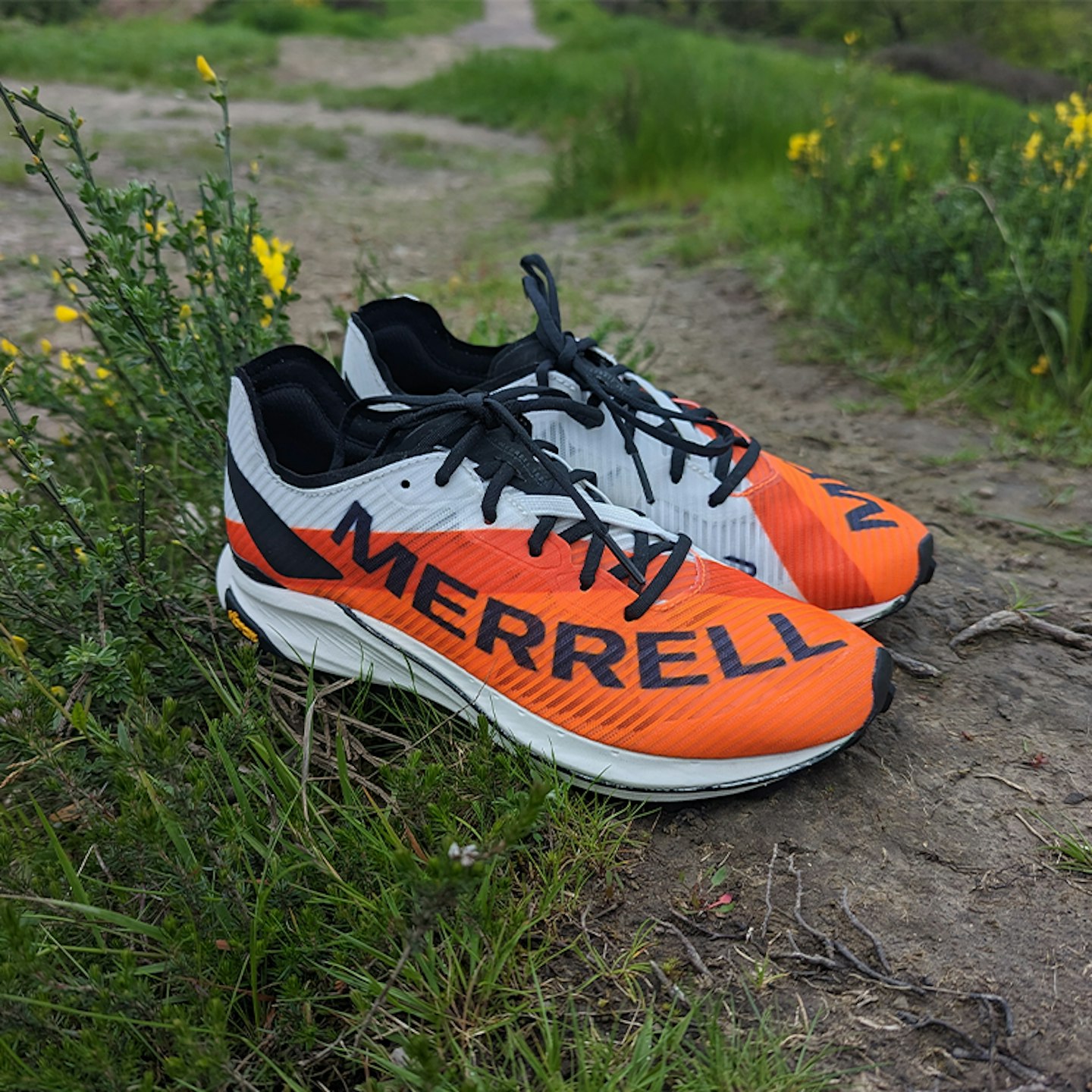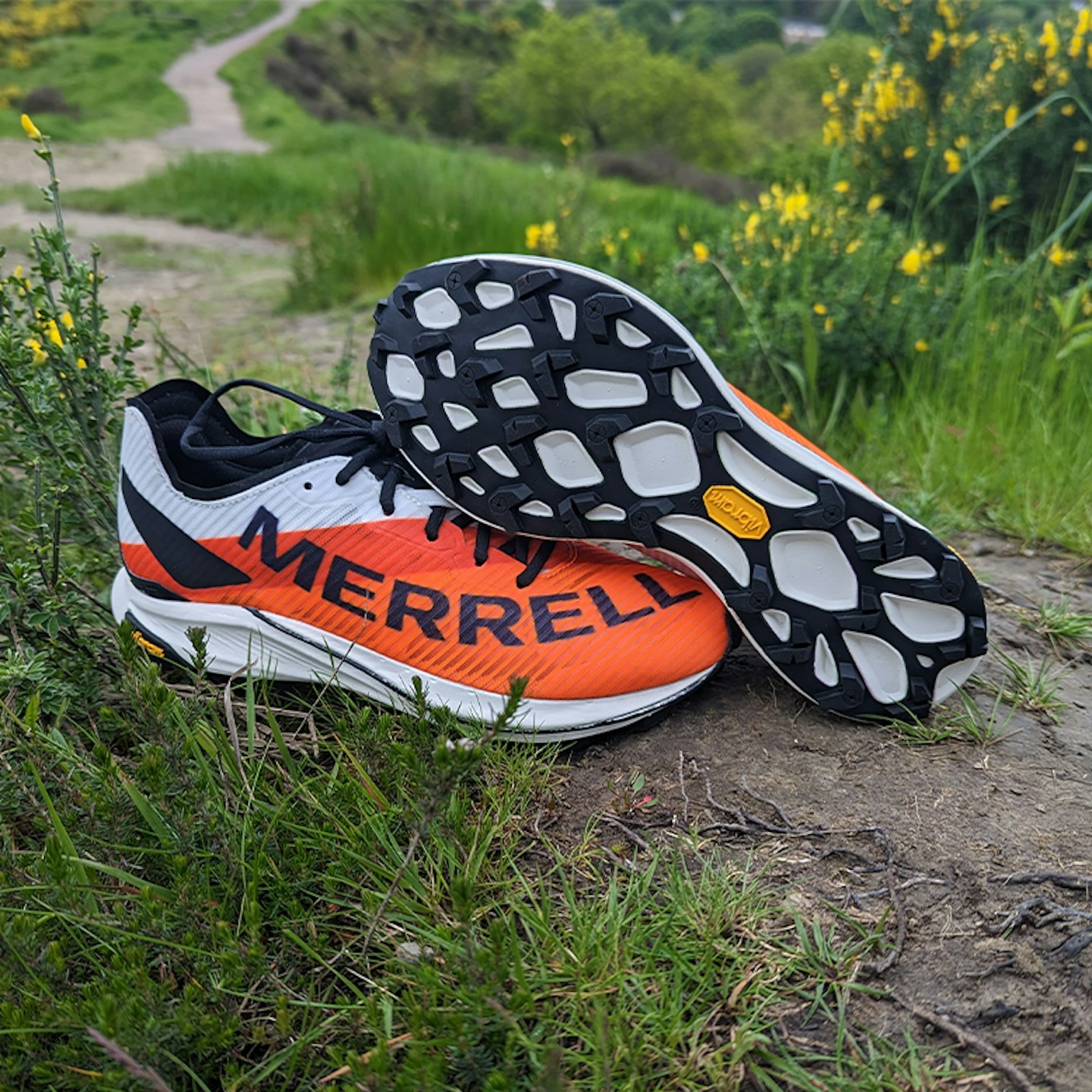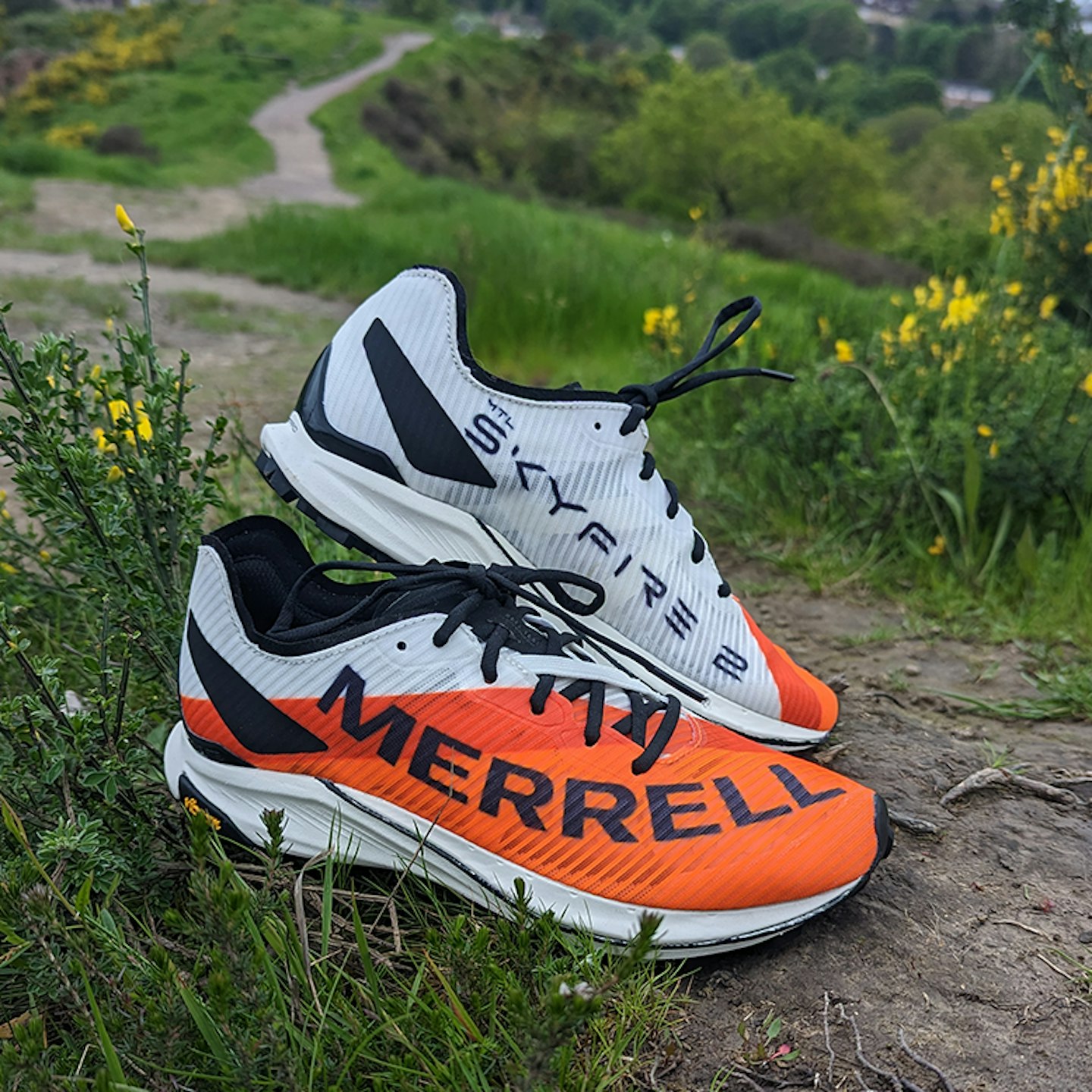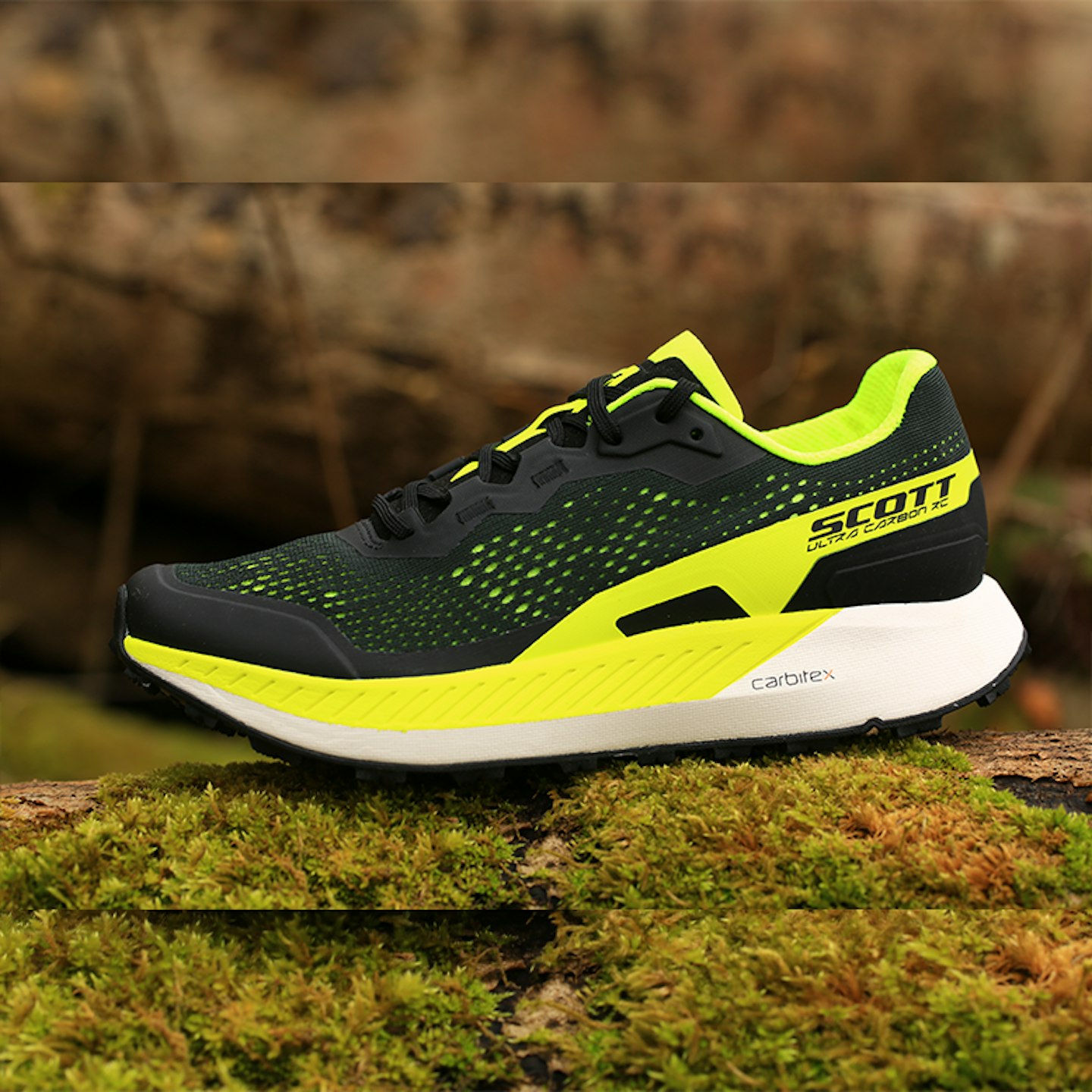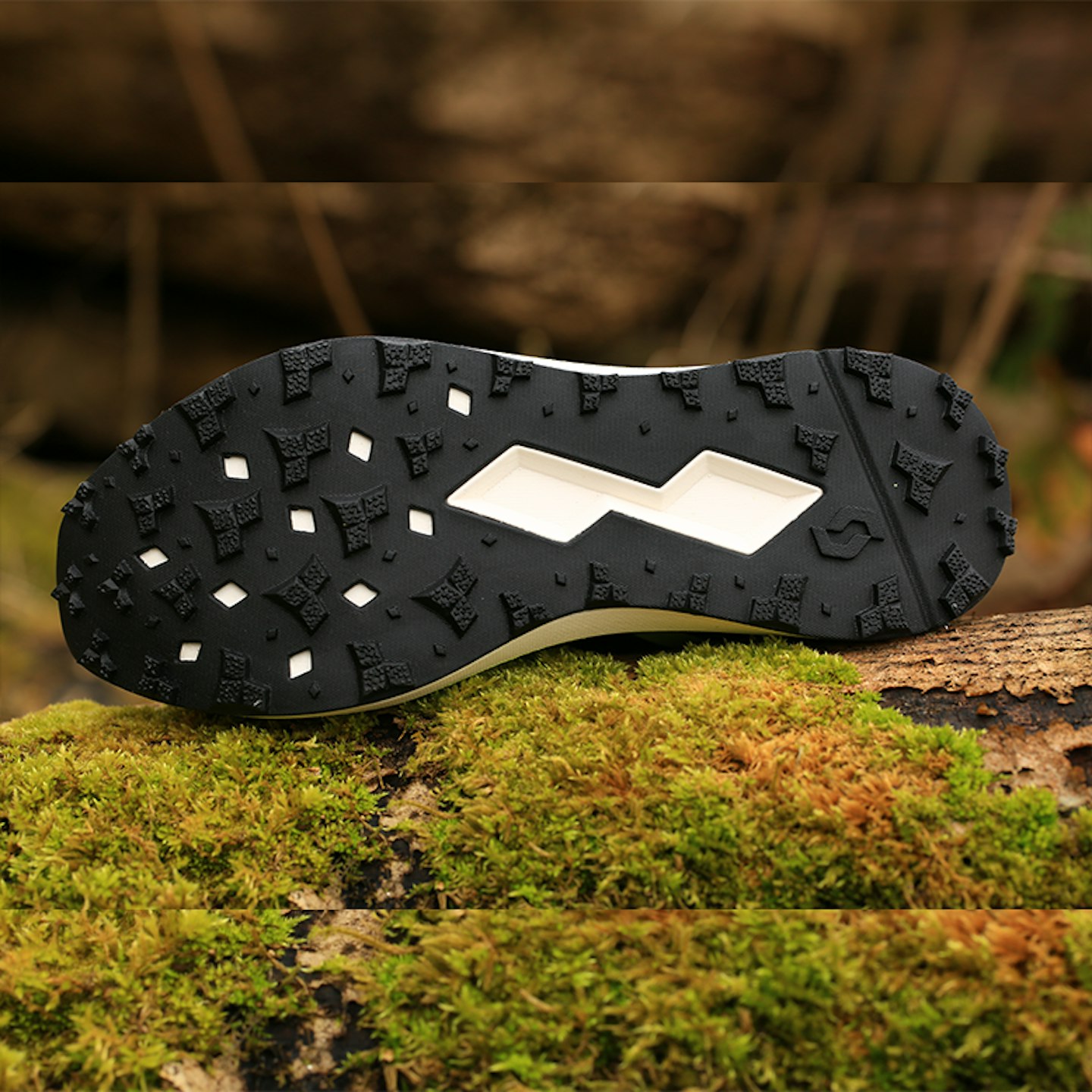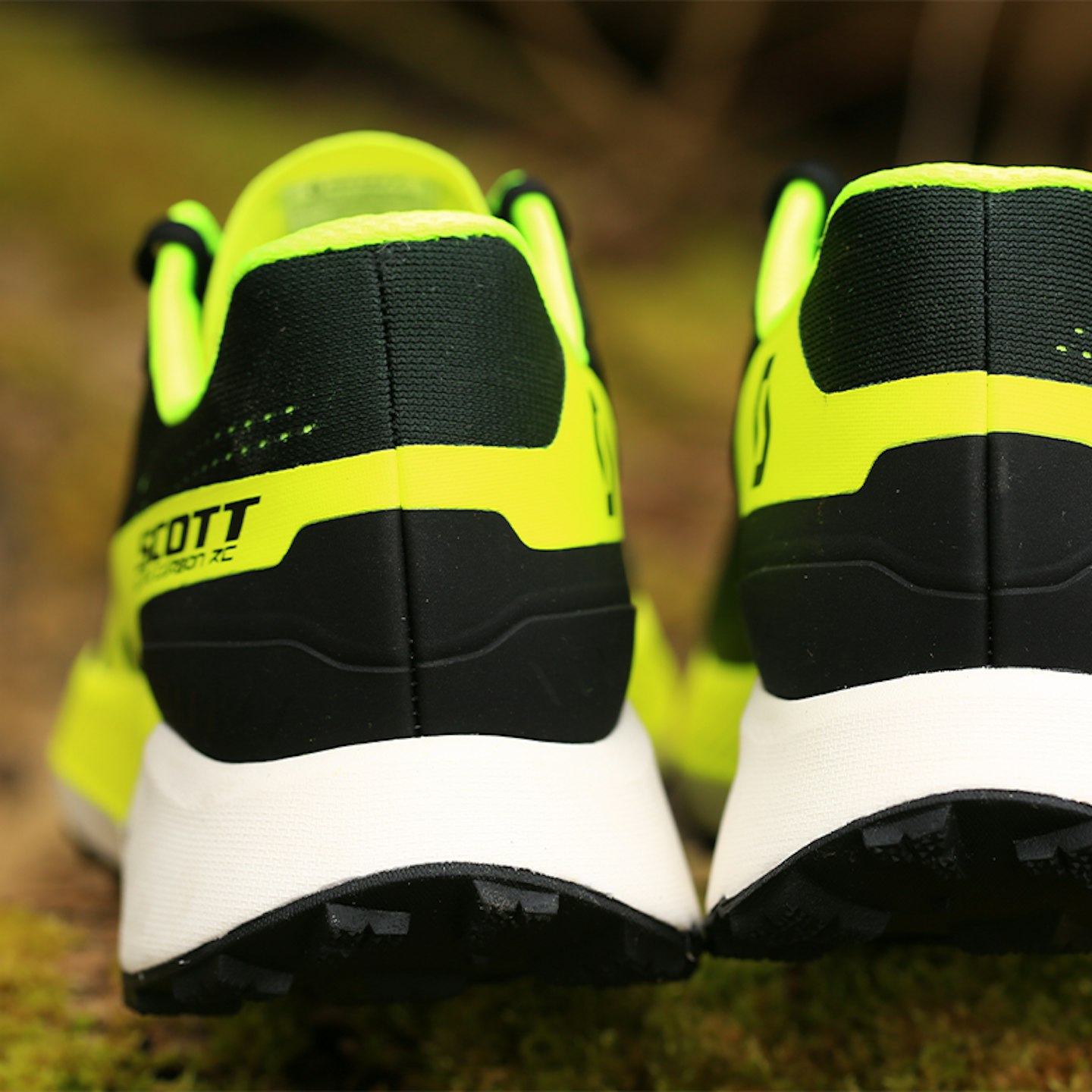Comfort is king when it comes to ultra trail running shoes. These are the shoes you should be able to rely on over long and arduous miles. The right shoe should make you feel like you can keep going forever, offering a blister-proof, supportive and lightweight ride.
First thing's first when you're looking to invest in any trail running shoe, you must have a good understanding of your own feet's anatomy and what structure of shoe works best for them.
Consider the width of your feet, if they're narrower than average then you'll want to look for brands who are known for a narrower fit, like Salomon.
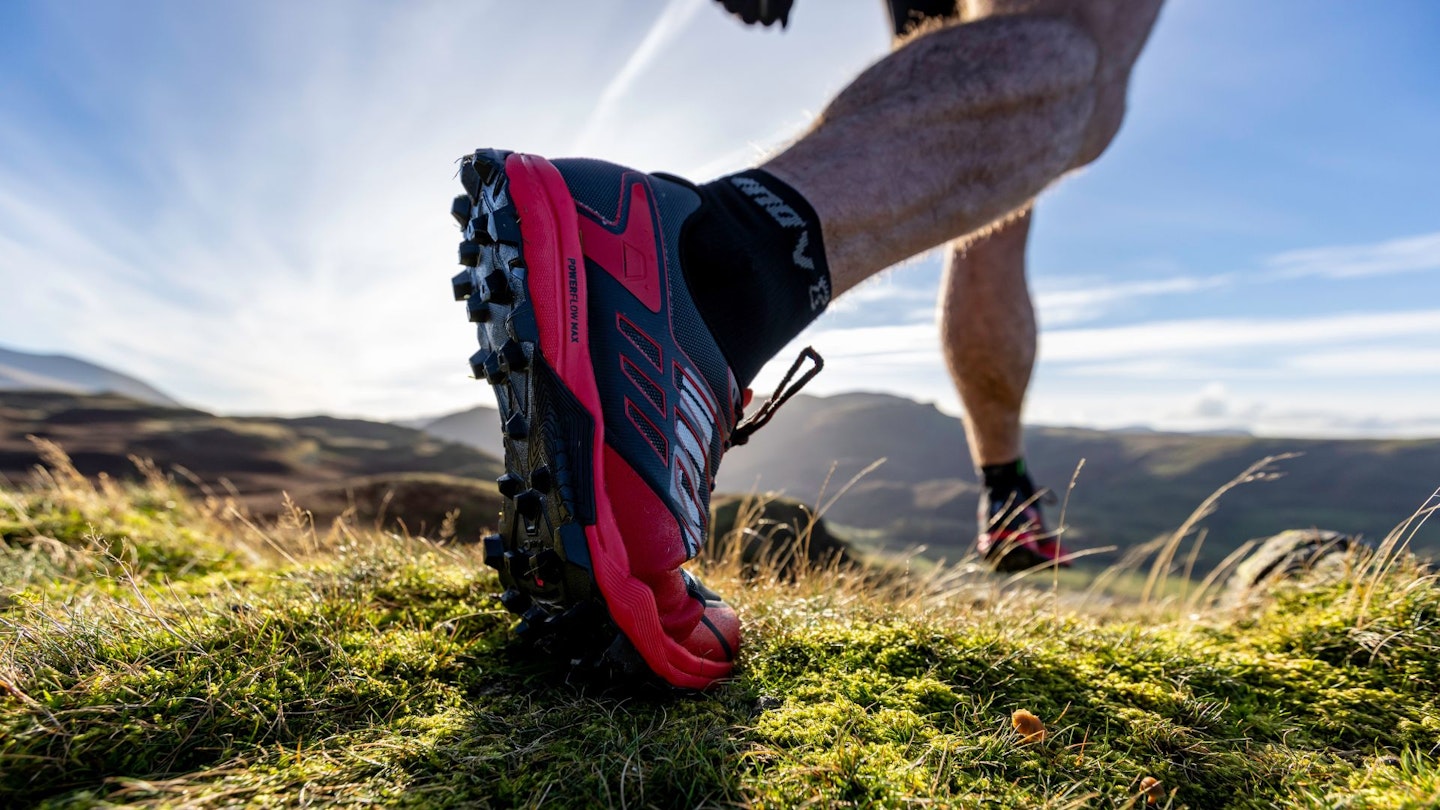
Or, for those with wider feet, a wider toe splay, or suffering with bunions, you'll probably want to reach for a shoe with more room in the toe-box to give your feet space to breathe. If your arches are high, you'll want to look at shoes with extra arch support, or even a stability shoe if you need some gait correction.
Once you understand what your feet need, you'll also need to consider features that optimise a trail running shoe for long distances.
The first thing is comfort, like that you'd see in a road to trail running shoe, but you should also consider the level of support, breathability, quality of the outsole and the terrain it's aimed at, and the fit.
What are the best ultra trail running shoes of 2025?
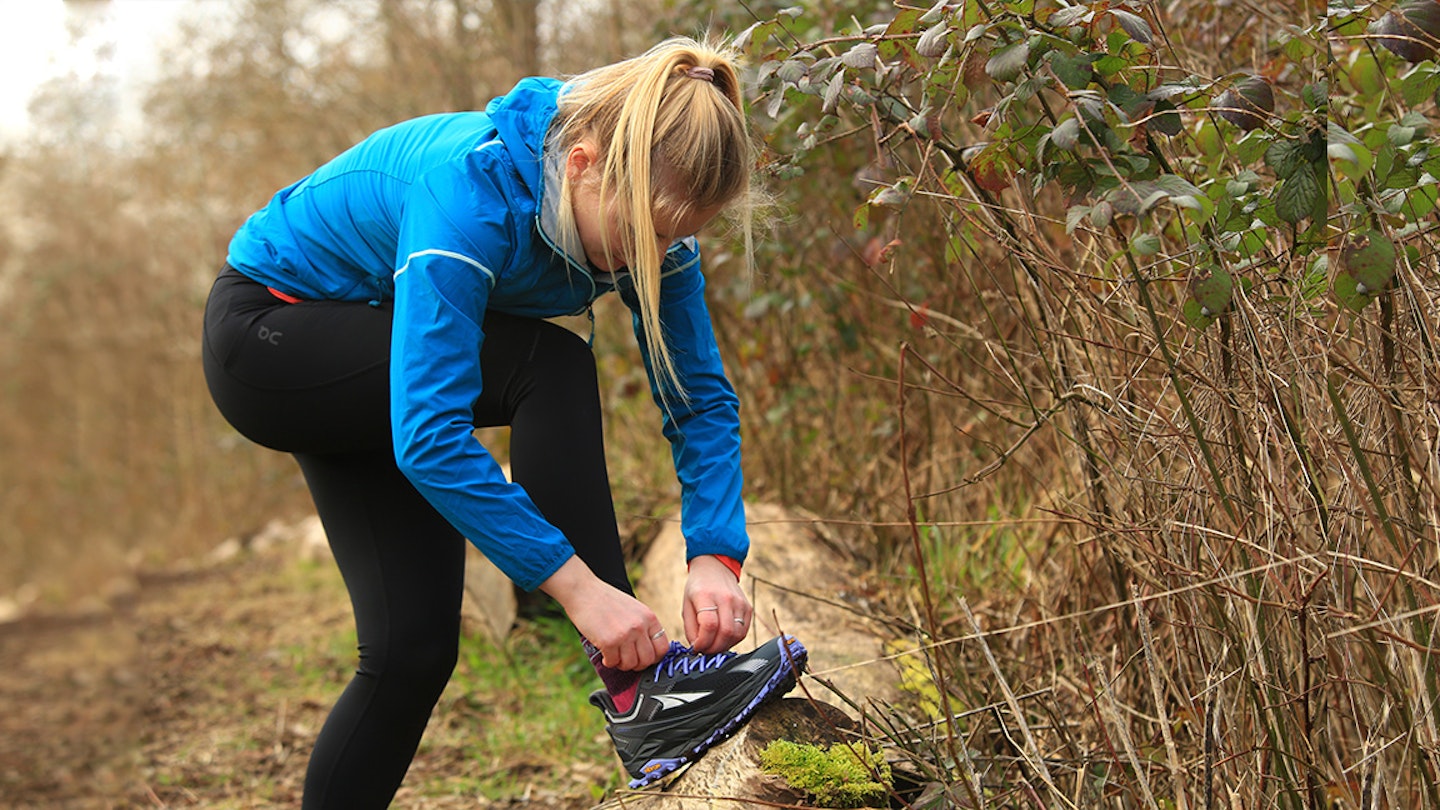
Best in Test – Hoka Mafate X
Best Value – Decathlon Evadict MT2
Best carbon-plated ultra shoe – Saucony Endorphin Edge
Best supportive ultra shoe – Dynafit Ultra 100
We asked trail running's top shoe brands to submit their best long-distance trail running shoes. In this article we thoroughly test a range of them, including ones with max cushioning, with carbon-fibre plates, and with zero drop, sharing our honest and unbridled opinion on each.
Below, we take a look at the merits of a range of long-distance trail running shoes and test their features across different terrain and distances. This will help you decide on the best ultra running shoe for you. We've also explained key features to look out for in a pair of ultra trail running shoes.
How we tested the best ultra trail running shoes

Between the three of us – Milo Wilson, Kate Milsom, and Lily Canter – we’ve racked up enough miles to lap the planet, and most of those have been in the name of testing gear. I (Milo (hi there!)) am LFTO’s full-time trail running gear tester, happiest on slower, longer runs that give me time to explore, and I have a bad habit of destroying shoes by taking them to ultra distances whenever I get away from my desk.
Lily is a professional run coach, an ultra racer, and the author of Ultra Women. Insert joke about her having literally wrote the book on ultra running here. Kate, meanwhile, has been racing cross-country since school, and has refused to stop increasing her mileage ever since.
She spent two years leading LFTO’s trail running section before moving to France and going freelance – though she still tests long-distance shoes for us.
Every pair on this list has been put through several months of real-world use, with hundreds of miles on a mix of terrain and in all weathers. We hammer all our trail running shoes, but doubly so for ultra trainers. We look for signs of premature wear and see how the cushioning, support, and fit hold up deep into their lifespan. Only the shoes that survive that punishment earn a place here.
When we test ultra trail running shoes, comfort is always king – you’re potentially wearing these for 12, 24, or even 48 hours at a time, so hotspots, pinching, or pressure points are dealbreakers.
But we also scrutinise support and energy return, both of which are vital for keeping form and efficiency late in a race. Striking the right balance is tricky, but after testing countless models – including many predecessors of the shoes on this list – we know what works for most runners tackling long, demanding distances.
Read our full guide for more info on how we test gear at LFTO.
Best ultra trail running shoes in detail:
The Hoka Mafate X is a carbon-plated trail shoe that blends long-distance comfort with real race potential. After struggling to find a carbon shoe that felt secure and stable off-road, our tester was surprised by how well the Mafate X delivered on both fronts.
Thanks to its three-layer midsole, including plush PEBA foam, a forked carbon plate and a base of supercritical EVA, you get a mix of soft cushioning and noticeable forward propulsion. It’s not the lightest shoe out there, but the payoff is real comfort and performance deep into an ultra.
We found the fit to be a standout feature – a wide toebox and padded, moulded heel counter create a secure yet accommodating feel, especially for runners who’ve struggled with Hoka’s traditionally narrow trail shoes. The woven upper is breathable and drains well, though the laces feel slightly flimsy.
Underfoot, the Vibram Megagrip outsole and 3.5mm lugs handle dry trails and rocky ground confidently. Grip suffers a little in the wet, and this isn’t one for technical mountain days, but the overall ride is smooth, stable and protected.
At £185, it’s expensive but not out of line for a premium carbon shoe. If you’re chasing long-distance comfort with a bit of zip, and want a carbon plate that feels stable rather than twitchy, the Mafate X is one of the best options we’ve tested.
Read our full Hoka Mafate X review or find the men's version here
Pros
- Excellent comfort
- Stable carbon plate
- Great fit
- Solid traction
Cons
- Bulky design
- Heavy under foot
| RRP: | £185/$225 |
| Weight: | 294g/10oz (women's), 344g/12oz (men’s) |
| Men's sizes (UK): | 7 – 11.5 |
| Women's sizes (UK): | 4 - 8.5 |
| Stack height: | 49 mm heel / 41 mm forefoot |
| Drop: | 8mm |
| Waterproof version? | No |
Decathlon says the Evadict MT2 is a mountain running shoe designed ‘for distances of 0 to 170km’. The successor of the MT, this newest version of the shoe prioritises stability and protection when running over rocky and rugged terrain.
The MT2 is a structured shoe with a fairly rigid upper and extra layers of protection up the sides and around the toes to ward off sharp trail debris. Naturally, a consequence of this is that the shoe is less breathable and a touch heavier than the really lightweight options on test.
The shoe’s camo-style outsole has a rockplate for further ground protection and fairly aggressive lugs. What we like about these is that the 8mm outer lugs jut out to the sides and do a great job of stabilising each footfall. We found they performed best over gravelly trails and loose terrain.
In terms of fit, the toe-box offers a good amount of room to accommodate feet swelling over long distances, though those with narrow feet may not get a completely locked-in fit. The cushioning in the tongue does feel a little overkill, but we found the mesh pouch for tucking away laces (also featured on the Scarpa Infinity Spin) to be a nice touch.
The MT2 achieves what it sets out to do, so if what you like in a long-distance trail shoe is that comfort and support, then this is a great affordable option. If you’re after a lightweight option, there’s Decathlon’s Race Ultra shoe or if it’s max padding you prefer, then take a look at the MT Cushion.
Pros
- Structured and protective
- Cushioned and comfortable
- Affordable and performs well
Cons
- May feel too rigid for some
| RRP: | £79.99 / $98.99 |
| Lug depth: | Up to 8mm |
| Weight per shoe (UK5.5): | 274g / 9.6oz |
| Drop: | 8mm |
Scarpa has a range of trail running shoes for all eventualities, but what the Spin Infinity focuses on is providing that necessary structure, comfort and stability for the longer distances.
The neutral, midweight trail shoe has a good level of structural support. The foot-wrapping overlay reaches up to the laces, which can be tightened to create a snug fit that hugs the foot in place, while a rigid heel counter offers more structural support. This is combined with a 4mm drop and slightly curved dual-density foam midsole, all of which come together to create a shoe with a good overall level of structure, without falling into the trap of becoming too stiff and unwieldy.
There’s a decent amount of padding along the heel and in the tongue, which Scarpa calls their ‘Adaptive Cushioning System’, it helps to keep the foot locked nicely in place, avoiding any heel slippage. The stack is also in that mid-range at 26mm, which offers ground protection without making you feel like you’re running in high heels.
Thanks to the panels of open mesh along the upper, the shoe manages to remain quite breathable in motion. There’s protection there too with the gusseted tongue and extended TPU toe bumper to protect from trail debris. A mesh pouch at the top of the tongue is there to tuck in laces, in theory this should prevent them coming undone mid-run.
Vibram Velox Cross lugs are 4mm in length, which means they can tackle a range of terrain but fare best along dry and less technical trails. Overall, the Scarpa Spin Infinity is a great all-rounder trail shoe that can hold up over those longer runs where you need that bit more support and comfort.
Read our Scarpa Spin Infinity review or find the men's version here
Pros
- Sturdy and supportive
- Enough cushion for longer distances
- Breathable and comfortable
- Grippy over range of terrain
Cons
- Not as agile/propulsive as some
| RRP: | £139.49 / $172.62 |
| Drop: | 4mm |
| Lug depth: | 4mm |
| Weight per shoe (UK5.5): | 268g / 9.45oz |
| Heel stack: | 26mm |
Merrell MTL Longsky 2 Matryx
Merrell has listened to feedback and revamped the MTL Longsky 2, this time focusing on durability. Our tester put the Matryx version through its paces across muddy Surrey trails and rocky Lake District fells, and it impressed with excellent traction and stability.
The standout feature is the Kevlar-reinforced Matryx upper. This durable material excels on rugged, rocky trails but sacrifices flexibility. The upper doesn’t stretch, which may cause discomfort during long runs, but for technical, mountain-focused runs, the trade-off is worth it. Sizing is a bit tricky, but the snug fit provides great precision on tough descents.
Underfoot, the FloatPro midsole offers a soft yet responsive ride, with good ground feel without feeling too stiff. The 4mm drop encourages a natural gait, though it might not suit those who prefer more cushioning. The Vibram MegaGrip outsole shines on wet and loose surfaces, and the aggressive 5mm lugs provide great grip, although the exposed foam could wear down over time.
While the MTL Longsky 2 is less versatile than some competitors, its durability, traction, and mountain-ready design make it ideal for serious trail runners tackling technical terrain. If you’re after a tough, reliable shoe for demanding runs, this one’s a top contender.
Read our MTL Longsky 2 Matryx review or find the women's version here
Pros
- Highly durable upper
- Great traction on wet ground
- Surprisingly lightweight
Cons
- Upper material doesn't stretch
- Less versatile than other options
| RRP: | £155 ($194.63) |
| Weight: | 241g / 8.5oz (UK size 9) |
| Lugs: | 5mm |
| Midsole: | FloatPro 100% recycled TPU EVA foam |
| Outsole: | Vibram MegaGrip rubber |
| Stack: | 23.5mm (heel), 19.5mm (forefoot) |
| Drop: | 4mm |
The Dynafit Ultra Pro 2 is a game-changer for ultra-distance runners. Designed for marathon distances and beyond, it features a plush ‘Speed Light’ midsole that tester Rachel Collins described as “a game-changer” on Scotland’s Torridon trails. At 280g, it’s surprisingly nimble for a maximalist shoe, delivering all-day comfort on compact, undulating routes.
The upper combines breathable, debris-blocking mesh with durable TPU overlays, while the roomy toe box and supportive heel padding kept Rachel’s feet happy over long runs. The Vibram outsole impressed with its durability, but its shallow 3.5mm lugs were less effective on wet or technical terrain. For runners sticking to dry, friendly trails, it’s a reliable and forgiving companion.
The standout quick-lacing system earned praise for its simplicity and secure fit, making shoe changes a breeze. While it’s not a pick for mud or steep technical climbs, the Ultra Pro 2 excels at providing comfort and control for long-distance adventures. Perfect for runners easing into high-cushion footwear or looking to push their limits.
Read our Dynafit Ultra Pro 2 review or find the men's version here
Pros
- Very comfortable cushioning
- Built to last
- A gentle introduction to a maximalist shoe
Cons
- Shallow lugs limit performance in wet and muddy conditions
| RRP: | £156.70 / $193.92 |
| Women’s sizes (UK) | 3-9 |
| Men’s sizes (UK) | 6-13 |
| Weight | 310g / 10.9oz men's, 270g / 9.5oz women's |
| Drop | 8mm |
| Lugs | 3.5mm |
If you're heading into an ultra or clocking up huge mileage on dry, hard-packed trails, the TrailFly Max is the best Inov8 shoe we’ve tested for the job.
With a huge dose of nitrogen-infused FlySpeed Pro foam underfoot and a redesigned NaturalFit last, this new release adds serious comfort and bounce without abandoning Inov8’s signature ground feel.
You get a 35mm heel stack and 6mm drop – enough for real underfoot protection and all-day comfort, but not so much that it feels disconnected or unstable.
In our testing, the TrailFly Max struck a rare balance: soft enough to feel plush, yet responsive enough to keep up the pace when fatigue sets in. The Boomerang insole adds a nice layer of rebound too, especially welcome on longer outings.
We also liked the lightweight, breathable upper, though it’s less robust than burlier models and might not stand up to seasons of abuse on rocky routes. Traction from the 4mm G-Grip graphene lugs was excellent on mixed terrain, particularly in the dry.
At £150, the TrailFly Max is good value for a performance-focused ultra-distance shoe. It's not built for deep mud or mountain scrambles – but for spring and summer trail ultras, we reckon this is Inov8’s most comfortable long-distance shoe yet.
Read our Inov8 TrailFly Max review or find the women's version here
Pros
- Grippy graphene outsole
- Very comfortable
- Highly cushioned
- Fast and light
Cons
- Not sure about long-term durability
| RRP: | £150 / $170 |
| Weight (per men's UK 8 shoe): | 292g / 10.3oz |
| Men's sizes: | UK 6-12 |
| Women's sizes: | UK 4-8.5 |
The La Sportiva Bushido III is a masterclass in stability and grip, excelling on technical terrain. Our Scotland-based tester put these shoes through their paces on Arthur’s Seat and beyond, and they handled everything from rocky scrambles to slippery trails with confidence.
The updated FRIXION Red bi-compound outsole delivers exceptional traction, with aggressive multi-directional lugs and La Sportiva’s impact braking system to keep you secure on descents. The compressed EVA midsole provides lightweight shock absorption and trail sensitivity, though its minimal cushioning might not be to every ultra runner's taste.
The breathable mesh upper impressed us with quick drying times and excellent ventilation, while the snug gusseted construction kept debris out. A wide-fit option is also available for those needing extra space.
Durability is a highlight here, with reinforced uppers and TPU overlays protecting the shoe from wear and tear. Sustainability gets a nod too, with recycled materials in the laces, insole, and mesh. Whether you’re tackling boggy paths or steep climbs, the Bushido III offers consistent performance and versatility.
If you prioritise stability and grip for technical trails, this shoe is hard to beat. While its lower-profile design may not suit all-day comfort seekers, it’s a fantastic choice for challenging runs and adventurous routes.
Read our La Sportiva Bushido III review or find the men's version here
Pros
- Durable and versatile
- Supreme grip and traction on wide range of surfaces
- Extremely breathable
Cons
- Less cushioning than other trail shoes
| RRP: | £125.99 / $155.92 |
| Men's sizes (UK): | 6.5–12 |
| Women's sizes (UK): | 3–9 |
| Drop: | 6mm |
| Stack height: | 30mm / 24mm |
| Weight: | 250g / 8.8oz per shoe (UK 5) |
The Brooks Cascadia 18 promises “adaptable stability,” and after testing it over a few tricky trail races, we’re inclined to agree. While it won’t win any awards for agility or speed, this shoe shines on rugged terrain where traction, cushioning, and durability take priority.
What stands out most is the redesigned midsole, which sinks the footbed deeper into the DNA Loft v2 cushioning and flexible rock plate. This setup provides excellent shock absorption without compromising ground feel. Over rocky sandstone and slippery boulders, the Cascadia felt stable and planted, with multi-directional lugs offering exceptional grip on both ascent and descent. The TrailTack Green Rubber outsole performed brilliantly, adapting to uneven terrain while resisting mud build-up.
The fit is generous, but dropping half a size gave our tester a snug and secure hold, particularly at the heel. While the upper’s perforated mesh was breathable and tough enough to fend off scuffs, the shoe’s chunky weight was noticeable on steep climbs. That said, it felt reassuringly protective on hard, unpredictable ground. In all, if you value comfort and confidence over speed, the Cascadia 18 is great pick.
Read our Brooks Cascadia 18 review or find the women’s version here
Pros
- Outstanding traction
- Excellent stability
- Toughened toe-box
- Reasonably flexible
Cons
- Its chunkiness means it’s fairly hefty
- Not as agile as sleeker competitors
| RRP: | £135 / $167.07 |
| Women’s sizes: | 3-10 |
| Men’s sizes: | 6-14 |
| Weight: | 322g / 11.3oz (men’s UK 8½ ) |
| Drop: | 8mm |
| Stack height: | 33mm heel, 25mm toe |
| Lugs: | 4.5mm |
| Versions: | Regular, wide |
Saucony’s Endorphin Edge is a very focussed and lightweight trail shoe. It’s intended for mixed terrain, but leans towards hard-packed trails, which is where you get the most bang for your buck with the carbon plate.
The midsole has a lot going on. Saucony’s Speedroll design aims for maximum forward propulsion, which is paired with heaps of foam cushioning. The result? A rather tall, neutral shoe, with a 35mm/29mm stack height.
Sandwiched in there is the Carbitex MonoFlex carbon fibre plate. The MonoFlex plate manages to be stiff in one direction for foot protection and to give propulsion uphill, also with lateral flex to turbocharge your running efficiency and give you downhill stability. Big tick.
The 4mm lugs and PWRTRAC outsole can cope with muddy terrain, but grip is definitely best on the more tightly-packed and flat trails.
The light and tightly-woven mesh upper is incredibly breathable and keeps debris out well. However, it’s very flexible, which appears to result in the shoe lacking stability on really technical trails.
Read our Saucony Endorphin Edge review or find the men's version here
Pros
- Lightweight and breathable
- Propulsive midsole and carbon plate
- Roomy toe-box
- Great for long-distance comfort
Cons
- Expensive
- Less at home on soft mud
| RRP: | £200 / $247.50 |
| Weight per shoe (UK5.5): | 224g / 7.9oz |
| Lug depth: | 4mm |
| Drop: | 6mm |
| Heel stack: | 35mm |
The Dynafit Ultra 100 stands out in look and features, it’s not your traditional trail running shoe. A touch heavier and with a sizeable stack, the Ultra 100 is made specifically for longer distances off the beaten path, where cushioning and support are your number one priority.
With this in mind, we can understand the appeal of these sturdy kicks, which have a good deal of protection from the mesh laces cover to the large toe-bumper and chunky stack raising you off the ground and out of the way of any sharp trail debris. The Pomoca outsole and lugs fared best on dry and hard trails, especially thriving over loose scree and gravel paths, while offering less traction over softer muddy sections.
In motion, the 261g weight (UK5.5) of the Ultra 100 is noticeable, but not enough to slow down your run significantly. What’s also apparent is the nice injection of cushioning around the heel and midsole, which helps keep the foot locked in place without causing any rubbing.
The neutral shoe has a 6mm drop which should suit most feet. Dynafit says a precision fit should allow for ‘plenty of blood flow to prevent the foot from swelling on long runs’. Going half a size up as advised, the shoe felt both snug and supportive, while having enough room for the toes to splay.
Pros
- Very sturdy and supportive
- Protective over rocky terrain
Cons
- Feel a little clumpy
- Not for extreme mud
| Heel stack | 32mm |
| Drop | 6mm |
| Lug depth | 4mm |
| Weight per shoe (UK5.5) | 261g |
The MTL Skyfire 2 is the lightest trail running shoe Merrell has ever made. When on, the low-volume shoe almost feels more like a sock, but in the best way possible, with one of our UK5.5 shoes weighing a tiny 171g. The high-tensile mesh and TPU upper is one of the slimmest and most breathable we’ve seen - so much so that a passing breeze easily permeates the upper. Needless to say, there was no overheating on the trails in these!
A modest 25mm stack means the feet sit relatively close to the ground, providing a high level of ground feel when running. Free from the entrails of a maximalist shoe, we felt a better precision and connection to the twists and turns of the trail.
Protecting the soles of the feet from any sharp bumps in the trail is Merrell’s ‘FlexPlate’ rockplate, which is sandwiched between two dual-density FloatPro Foam midsole layers. Doing away with the stiffness of some carbon plates, this full-length plastic-composite plate adds structure and stability to the shoe, while remaining flexible and relatively responsive.
The Skyfire 2 excels best during fast runs, though due to the light cushioning, the impact was more noticeable when doing sustained efforts over hard-packed terrain. The Vibram MegaGrip outsole has been made custom to the Skyfire 2, the thin spider web design sports grippy 6mm lugs.
If you’re after a fast and precise trail shoe with excellent ground feel, the Skyfire 2 is hard to beat for up to the marathon distance. But for those who prefer a touch more protection and cushioning, take a look at the other less minimal shoes in this round-up.
Read our Merrell MTL Skyfire 2 review or find the men's version here
Pros
- Extremely light and breathable
- Agile and fast
- Good ground feel and precision
Cons
- Less structural support and cushioning than some
| Heel stack | 25mm |
| Drop | 6mm |
| Lug depth | 6mm |
| Weight per shoe (UK5.5) | 171g |
Scott pens the Scott Ultra Carbon RC as their 'most technological trail racing product to date' due to its in-built carbon plate and rocker shape. It’s made to excel on easy and rolling (read, hilly) trails in a racing environment where speed is of the essence.
Let’s start with the most exciting feature, the Carbitex GearFlex carbon plate is made to be pliable during easy running, while simultaneously having the ability to become stiffer and thus, more responsive to an increase in speed. The plate has a ‘swallow tail’ shape which splits towards the heel to allow for more lateral flex, while the rocker is intended to encourage a more dynamic running gait for better running economy. Though the weight of the shoe is on the heavier side for carbon kicks, the propulsion caused by the rocker and plate really helps minimise the effects of this.
In action, it’s obvious the RC is a good-quality build, the first thing that hit us was how sturdy and supportive it felt. There’s a medium amount of cushioning which is most evident around the collar and dual-density midsole foam that has a 25mm stack, while the 5mm drop makes this a neutral yet supportive-feeling shoe. The downside to this being that the shoe felt a little lacking in flex and agility.
The outsole and lugs provide traction along a range of terrain, while the engineered mesh upper has an extra injection of protection from a TPU layer which extends out from the toe bumper. While this may equal brownie points for durability in the long run, we felt it weighed down the 292g (UK5.5) shoe and made it feel less breathable in action.
Pros
- Lots of stability and structure to the shoe
- Rocker aids momentum
- Bright colourways
- Durable feel
Cons
- Not as agile as others
- Feels a little too rigid
- Less affordable than others
| Heel stack | 25mm |
| Drop | 5mm |
| Lug depth | 3mm |
| Weight per shoe (UK5.5) | 292g |
What to look for in a long-distance running shoe
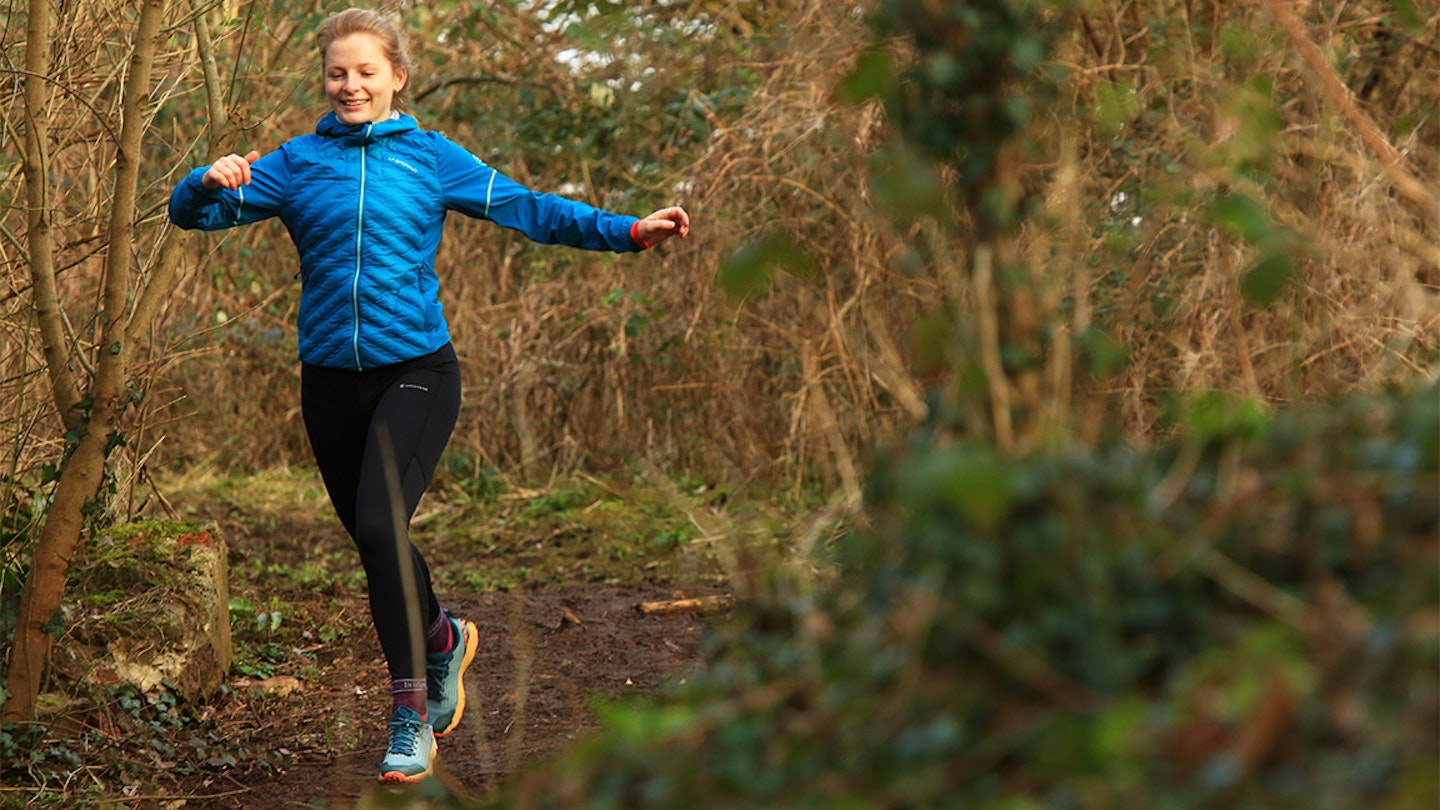
When you’re heading into ultra territory, the right shoe can make the difference between cruising to the finish or hobbling home early. Here’s what we prioritise when choosing a shoe for 50km, 100km, or beyond.
Materials
Durability matters more than ever at ultra distances, so look for high-quality engineered mesh uppers with reinforced overlays in high-wear areas. Many premium shoes now use recycled or Bluesign-approved fabrics without compromising toughness. For midsoles, responsive foams like EVA blends or PEBA can deliver the long-lasting cushioning you’ll need, but make sure they’re paired with enough protection underfoot to stave off fatigue over hours of running.
Drop
Heel-to-toe drop can influence your running mechanics over long distances. Most ultra shoes fall between 4mm and 8mm, striking a balance between a more natural footstrike and enough heel cushioning for comfort when fatigue sets in. If you’re switching to a lower drop than you’re used to, build up gradually to avoid calf strain.
Comfort
Comfort is king in ultra running shoes. You’ll want a plush yet responsive midsole, enough room in the toe box for natural swelling, and uppers that secure the foot without pressure points. Breathability matters too, especially on hot multi-hour runs, but make sure ventilation isn’t at the expense of weather protection.
Fit
Over an ultra distance, a bad fit will punish you relentlessly. A snug midfoot hold is key for stability on technical terrain, while the forefoot should allow your toes to splay. Consider whether you’ll be wearing thicker socks for winter races, and if so, size accordingly. Lacing systems – traditional, quick-lace, or BOA – should feel secure and be easy to adjust mid-run.
FAQs
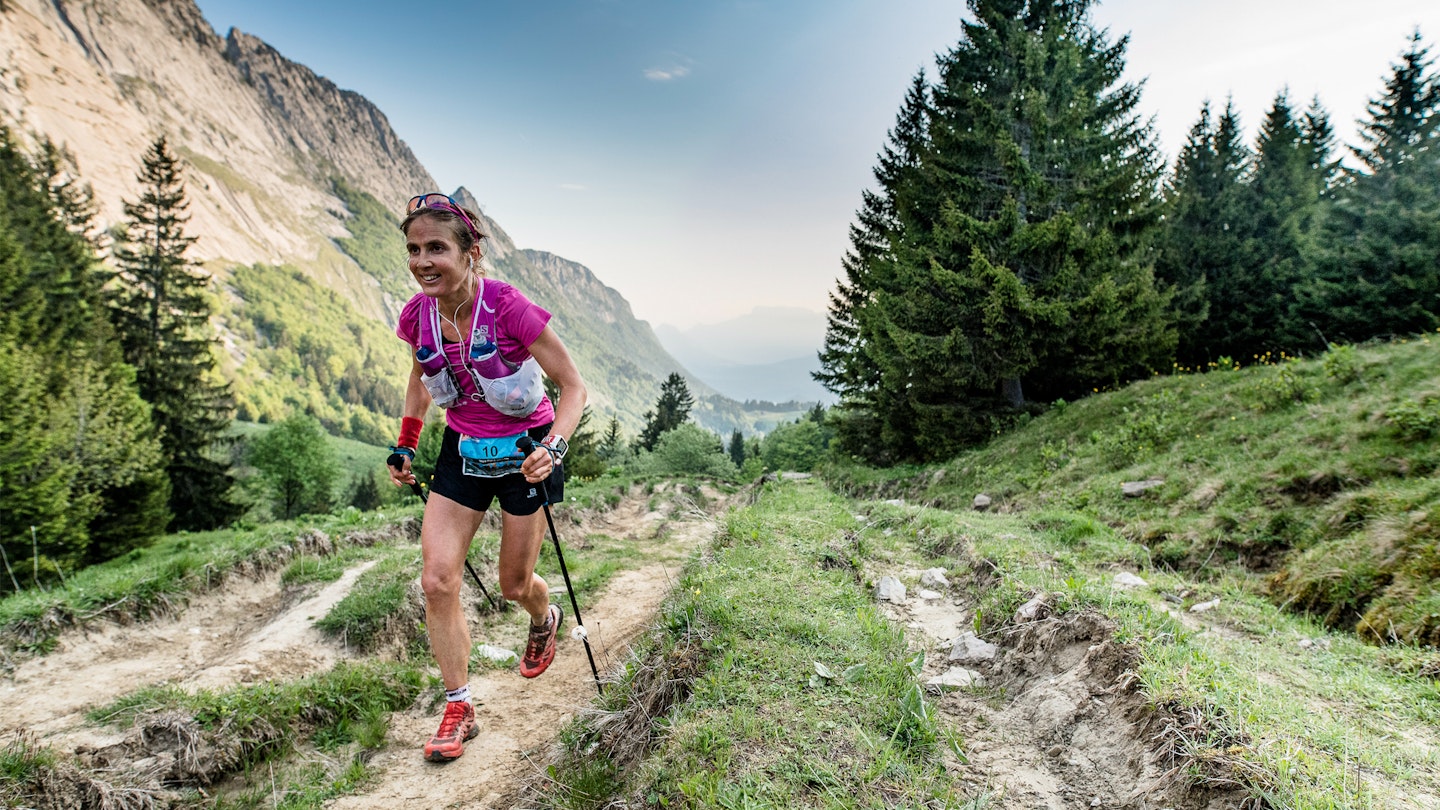
What’s the difference between an ultra running shoe and a regular trail shoe?
Ultra running shoes prioritise long-haul comfort, durability, and protection over sheer speed. They often feature more cushioning, a roomier fit, and midsoles designed to maintain their bounce for dozens of hours. Regular trail shoes can work for shorter ultras, but if you’re tackling very long distances, a dedicated ultra shoe will better protect your feet and joints.
Do I need a carbon plate for ultra running?
Not necessarily. While some ultra shoes include carbon or composite plates for propulsion and rock protection, others skip them to prioritise flexibility and comfort. A plate can be useful on flatter, faster courses, but over technical or mountainous terrain, many runners prefer a softer, more adaptable feel.
Should I size up for an ultra?
Some runners go up half a size to accommodate swelling, especially for 100km+ events. However, it’s a personal choice. Too much extra room can cause slippage and blisters, so make sure any sizing change still gives you a secure midfoot and heel hold.
How long will an ultra running shoe last?
Expect 500–800km from a well-made ultra shoe, depending on the terrain and your running style. Technical, rocky ground can wear out the outsole faster, while softer trails will help them last longer. We recommend rotating two pairs if you’re training for a big event to extend lifespan and keep cushioning fresh.
If these terms are confusing, take a look at our trail running shoe buyer's guide to better understand key features of a run shoe and how they fit.
About the authors
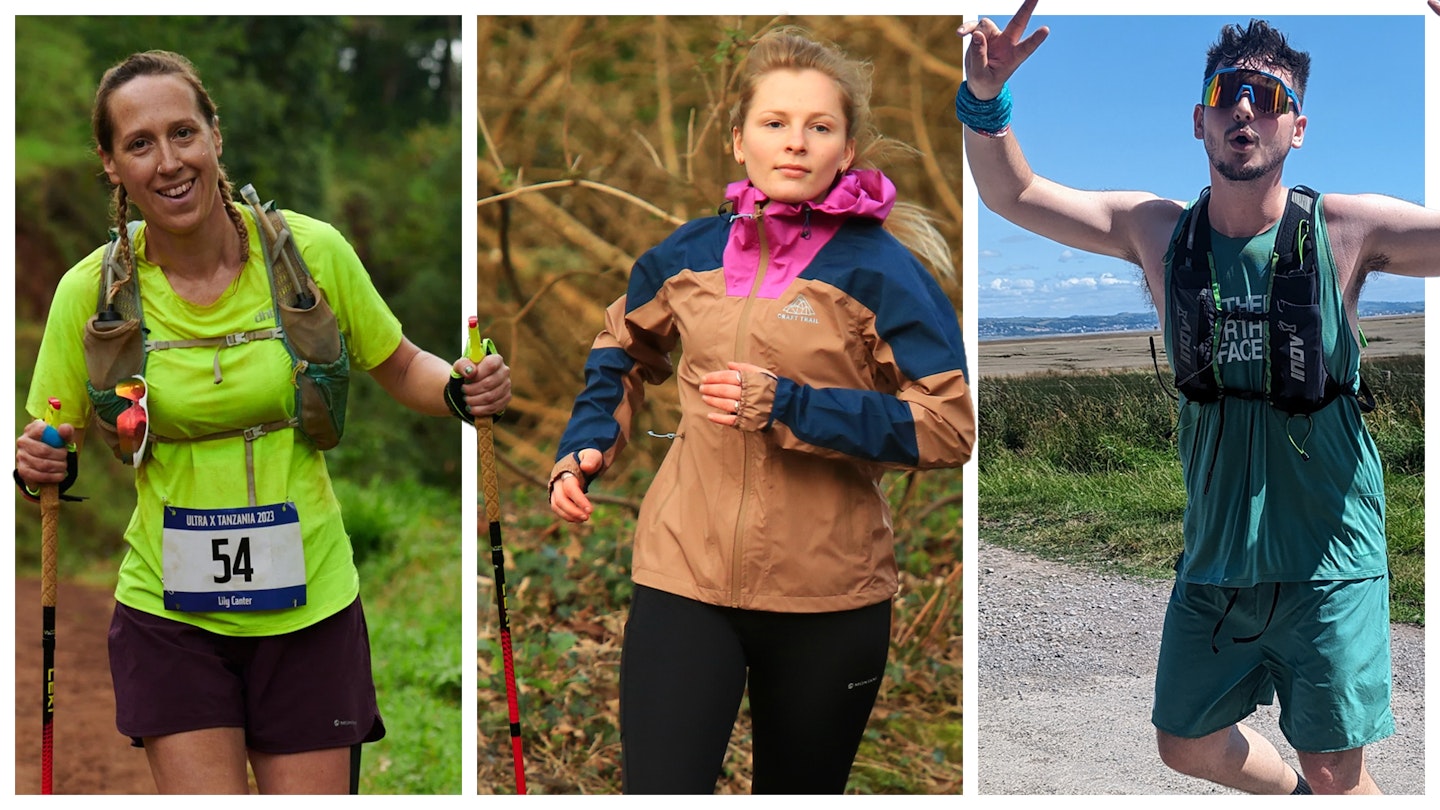
Milo Wilson is LFTO’s resident trail running gear guru, with a focus on longer, slower runs that prioritise exploration. A hiker-turned-runner, Milo got into trail running to cover more ground in a day and has since tested hundreds of shoes, taking many of them up to ultra distances in the name of thorough reviewing.
Kate Milsom is an ultra runner and long-time gear tester who has been competing in cross-country races since school. She spent two years as LFTO’s trail running editor before moving to France, where she now freelances – though she still returns to test the latest long-distance shoes for us.
Lily Canter is the founder of women's running group Great Bowden Runners. She's also a professional run coach, ultra racer, and author of Ultra Women. Her years of coaching and racing give her deep insight into what makes a shoe survive – and thrive – at the kinds of distances most runners can only dream of.
